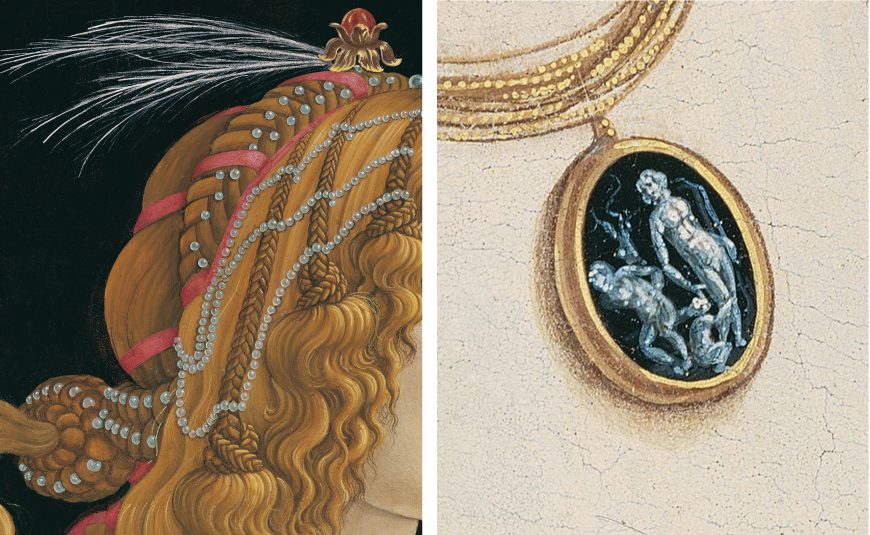7.4: Italy in the 15th century- Early Renaissance (I)
- Page ID
- 67070
Italy: 15th century
The Italian city-states were filled with art—all powered by thriving merchant economies.
1400 - 1500 (Early Renaissance)
Beginner’s guide: Italy in the 15th century
This period is often called the Early Renaissance.
1400 - 1500
Carefully observing the natural world, relying on scientific and mathematical tools, and imitating aspects of ancient Greek and Roman art are the cornerstones of the Italian Renaissance.
How to recognize Italian Renaissance art
by DR. BETH HARRIS and DR. STEVEN ZUCKER
Video \(\PageIndex{1}\): A brief introduction to Italian Renaissance art
Illustrating a Fifteenth-Century Italian Altarpiece
by THE METROPOLITAN MUSEUM OF ART
Video \(\PageIndex{2}\): Video from The Metropolitan Museum of Art.
The study of anatomy
by DR. STEVEN ZUCKER and DR. BETH HARRIS
Picking up from the ancients

We can see from Donatello’s sculpture of David—with its careful depiction of bones and muscles and a nude figure—that the study of human anatomy was enormously important for Renaissance artists. They continued where the ancient Greeks and Romans had left off, with an interest in creating images of the human beings where bodies moved in natural ways—in correct proportion and feeling the pull of gravity.
Sculptures from ancient Greece and Rome reveal that classical artists closely observed the human body. Ancient Greek and Roman artists focused their attention on youthful bodies in the prime of life. Ancient sources indicate these artists used models to help them study the details of the body in the way that it looked and moved. These artists tried to show their viewers that they understood systems of muscles beneath the skin.

In the Middle Ages, there was very little interest in the human body, which was seen as only a temporary vessel for the soul. The body was seen as sinful, the cause of temptation. In the Old Testament, Adam and Eve eat the apple from the tree of knowledge, realize their nakedness, and cover themselves. Due to the nudity in this important story, Christians associated nudity with sin and the fall of humankind. Medieval images of naked bodies do not reflect close observation from real life or an understanding of the inner workings of bodies.


Dissection
The best way to learn human anatomy is not just to look at the outside of the body, but to study anatomy through dissection. Even though the Catholic Church prohibited dissection, artists and scientists performed dissection to better understand the body. Renaissance artists were anxious to gain specialized knowledge of the inner workings of the human body, which would allow them to paint and sculpt the body in many different positions.
The artists of the Early Renaissance used scientific tools (like linear perspective and the study of anatomy and geometry) to make their art more naturalistic, more like real life. The term “naturalism” describes this effort.
Scientific naturalism allowed artists in the Early Renaissance to begin to demand that society think of them as more than just skilled manual laborers. They argued that their work—which was based on science and math—was a product of their intellect just as much as their hands. They wanted artists to have the same status as intellectuals and philosophers, unlike the medieval craftsmen that came before them.
Contrapposto explained
by DR. STEVEN ZUCKER and DR. BETH HARRIS
Video \(\PageIndex{3}\): A discussion about contrapposto while looking at “Idolino” from Pesaro, (Roman), c. 30 B.C.E., bronze, 158 cm (Museo Archeologico Nazionale di Firenze), speakers: Dr. Beth Harris and Dr. Steven Zucker
Although these particular objects may not have been known in the Renaissance, the ideas and form of contrapposto were revived in the Italian Renaissance.
Smarthistory images for teaching and learning:
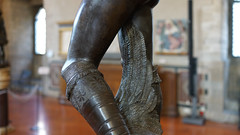
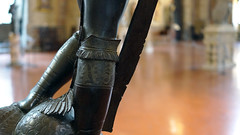
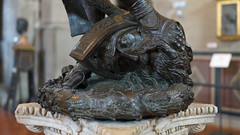
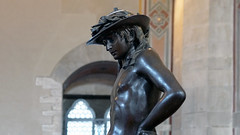

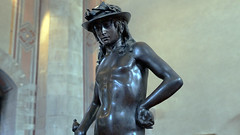

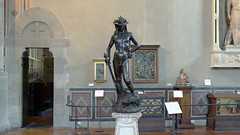
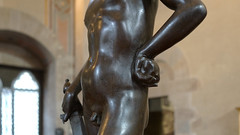
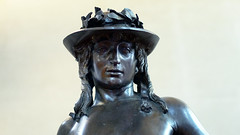

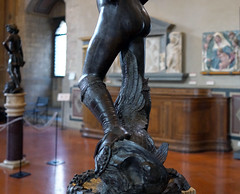
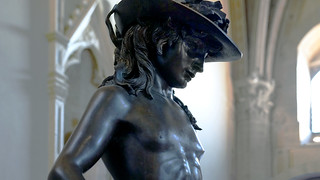

Florence in the Early Renaissance
by DR. STEVEN ZUCKER and DR. BETH HARRIS
The Renaissance really gets going in the early years of the fifteenth century in Florence. In this period, which we call the Early Renaissance, Florence is not a city in the unified country of Italy, as it is now. Instead, Italy was divided into many city-states (Florence, Milan, Venice etc.), each with its own government (some were ruled by despots, and others were republics).
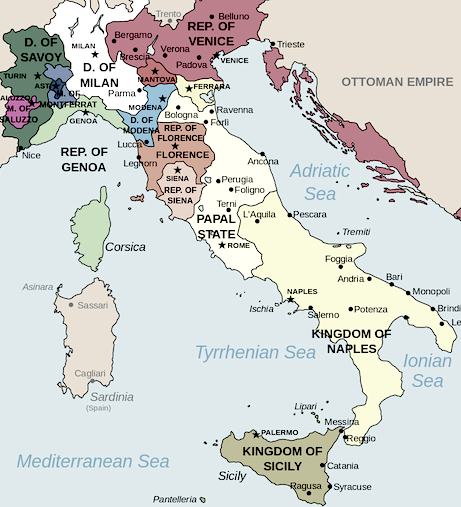
The Florentine Republic
We normally think of a Republic as a government where everyone votes for representatives who will represent their interests to the government (think of the United States pledge of allegiance: “and to the republic for which it stands…”). However, Florence was a Republic in the sense that there was a constitution which limited the power of the nobility (as well as laborers) and ensured that no one person or group could have complete political control (so it was far from our ideal of everyone voting, in fact a very small percentage of the population had the vote). Political power resided in the hands of middle-class merchants, a few wealthy families (such as the Medici, important art patrons who would later rule Florence) and the powerful guilds.
Why did the Renaissance begin in Florence?
There are several answers to that question: Extraordinary wealth accumulated in Florence during this period among a growing middle and upper class of merchants and bankers. With the accumulation of wealth often comes a desire to use it to enjoy the pleasures of life—and not an exclusive focus on the hereafter.
Florence saw itself as the ideal city state, a place where the freedom of the individual was guaranteed, and where many citizens had the right to participate in the government (this must have been very different than living in the Duchy of Milan, for example, which was ruled by a succession of Dukes with absolute power). In 1400 Florence was engaged in a struggle with the Duke of Milan. The Florentine people feared the loss of liberty and respect for individuals that was the pride of their Republic.
Luckily for Florence, the Duke of Milan caught the plague and died in 1402. Then, between 1408 and 1414 Florence was threatened once again, this time by the King of Naples, who also died before he could successfully conquer Florence. And in 1423 the Florentine people prepared for war against the son of the Duke of Milan who had threatened them earlier. Again, luckily for Florence, the Duke was defeated in 1425. The Florentine citizens interpreted these military “victories” as signs of God’s favor and protection. They imagined themselves as the “New Rome” — in other words, as the heirs to the Ancient Roman Republic, prepared to sacrifice for the cause of freedom and liberty.
The Florentine people were very proud of their form of government in the early fifteenth century. A republic is, after all, a place that respects the opinions of individuals, individualism was a critical part of the Humanism that thrived in Florence in the fifteenth century.
Additional resources:
Tour: The Early Renaissance in Florence (from the National Gallery of Art)
Smarthistory images for teaching and learning:

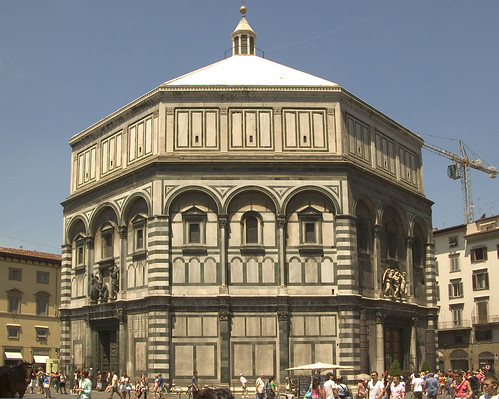
Alberti’s revolution in painting
by DR. LAUREN KILROY-EWBANK and DR. HEATHER GRAHAM
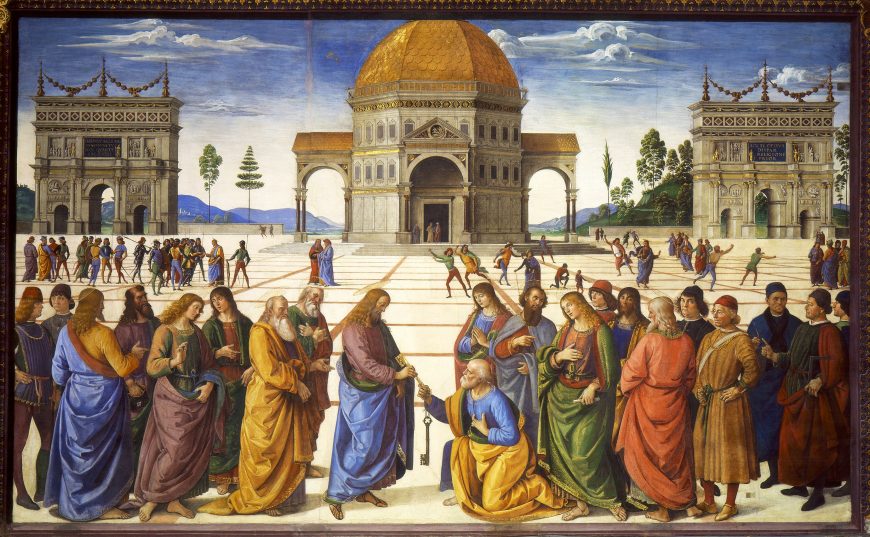
In a fresco high on one wall of the Sistine Chapel, the aged Saint Peter kneels as he humbly accepts the keys of heaven from Jesus Christ standing before him. These two central figures are joined in the immediate foreground by a group of men to either side, some dressed in ancient styles, others in cutting-edge fifteenth-century fashion. They all have volumetric bodies that suggest gentle movement and expressions of solemn concentration. A wide piazza opens behind them, with figures and the piazza’s paving stones receding in scale to suggest a deep space. Forms on the distant horizon fade into an atmospheric haze. A massive building and two triumphal arches, set at even intervals in the background, convey a sense of balance and geometric solidarity.
Pietro Perugino’s biblical scene displays many of the key elements identified as necessary for a successful painting by Leon Battista Alberti in his treatise about painting, including:
- Convincing three-dimensional space
- Light and shadow to create bodies that look three-dimensional
- Figures in varied poses to create a compelling narrative
Alberti’s De Pictura (On Painting, 1435) is the first theoretical text written about art in Europe. Originally written in Latin, but published a year later in the Italian vernacular as Della Pittura (1436), this was the first artistic treatise to describe linear perspective and is the first known text in Europe to discuss the purpose of painting. Filippo Brunelleschi’s experiments in linear perspective had occurred earlier in the 1420s, but Alberti codified these ideas in writing. It was during his time living in Florence that Alberti developed his thoughts on painting as he interacted with artists such as Brunelleschi, Donatello, Lorenzo Ghiberti, Masaccio, and others.
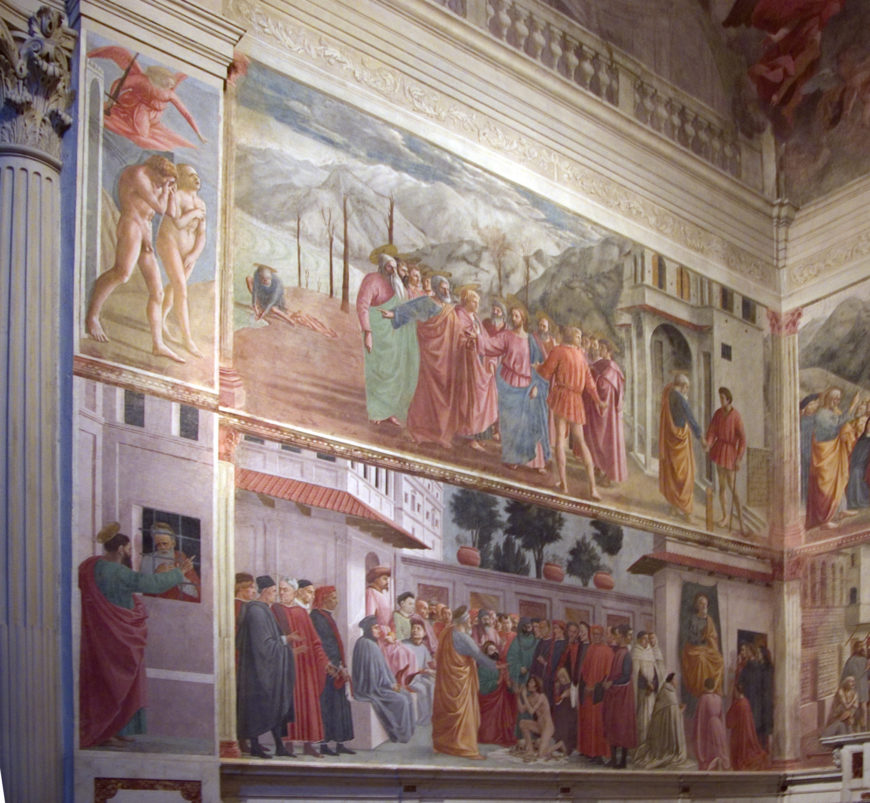
These artists experimented with linear perspective before Alberti wrote his text, as we see in Masaccio’s frescoes in the Brancacci Chapel or Donatello’s bronze The Feast of Herod. Alberti encountered first-hand works like Masaccio’s fresco cycle on the life of Saint Peter where biblical characters are convincingly three-dimensional, walk upon solid ground casting shadows, and interact emotionally to tell a story. He dedicated the Italian version of On Painting to the artists from whom he had learned his practical ideas. Alberti’s treatise was more ambitious than simply telling painters how to construct convincing three-dimensional space though. For him, painting “contains a divine force which not only makes absent men present . . . but moreover makes the dead seem almost alive.” [1]
Creating three-dimensional space
Know that a painted thing can never appear truthful where there is not a definite distance for seeing it.
Alberti, On Painting, book 1:46
Alberti believed that good and praiseworthy paintings need to have convincing three-dimensional space, such as we see in Perugino’s fresco. In the first section of On Painting, he explains how to construct logical, rational space based on mathematical principles. It is here that he writes about linear perspective and how to construct a geometrically calculated vanishing point around which a painting’s composition is centered.
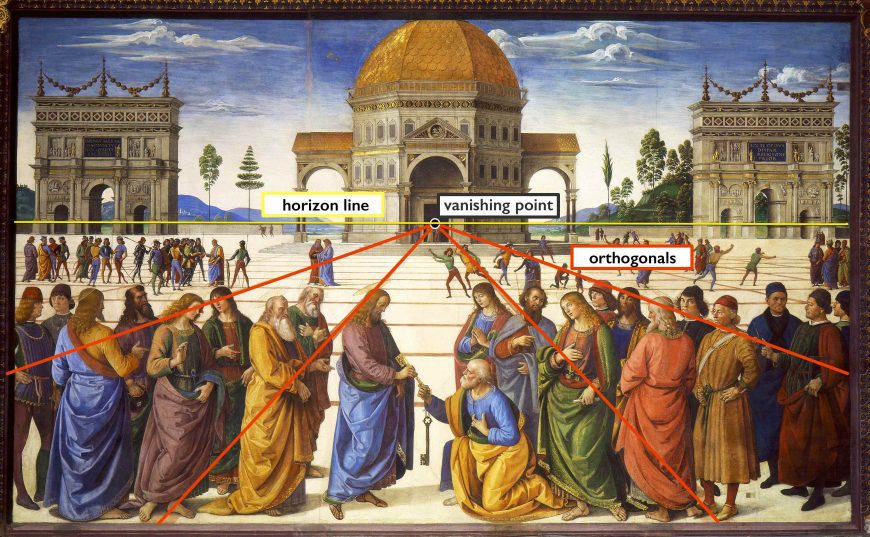
A painting attributed to Luciano Laurana of an ideal city envisions Alberti’s ideas. The painting shows a perfectly symmetrical and mathematically defined cityscape. All of the forms within the painting appear to recede away from the viewer and converge at a single point at the center of the horizon line. By having a single vanishing point, Alberti was instructing viewers to look at a painting like The Ideal City as if it were viewed through a window frame.

Making figures look real
There are some who use much gold in their istoria. They think it gives majesty. I do not praise it. Even though one should paint Virgil’s Dido whose quiver was of gold, her golden hair knotted with gold, and her purple robe girdled with pure gold, the reins of the horse and everything of gold, I should not wish gold to be used, for there is more admiration and praise for the painter who imitates the rays of gold with colors.
Alberti, On Painting, book 2:83
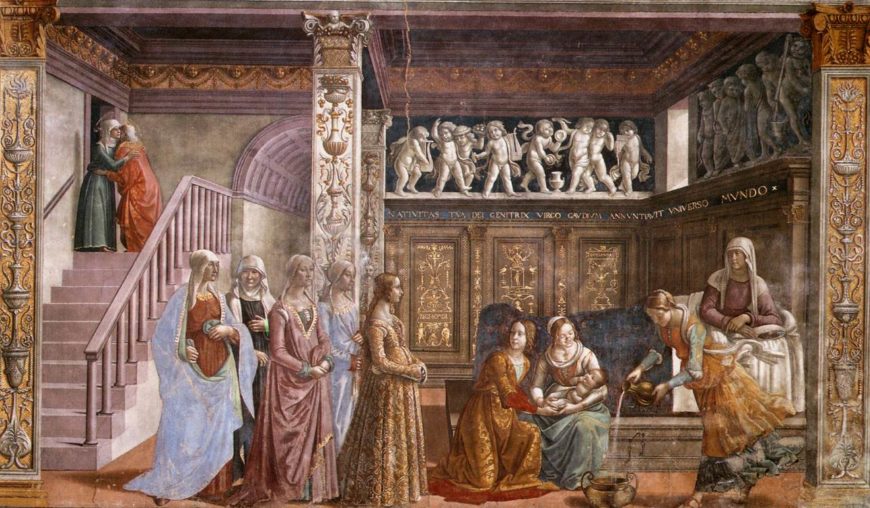
For Alberti, the ultimate artistic goal of painting was to rival Nature in the depiction of visual reality. Forms within a painting should be modeled with light and shade to appear sculptural, as though they stand out from the two-dimensional surface like the forms in ancient relief sculpture. Domenico Ghirlandaio’s fresco depicting the birth of the Virgin Mary includes precisely the kind of convincing naturalism Alberti desired. In the scene, women cast shadows, and the deep folds and pleats in their dresses give the impression that their bodies take up space in the two-dimensional fresco.
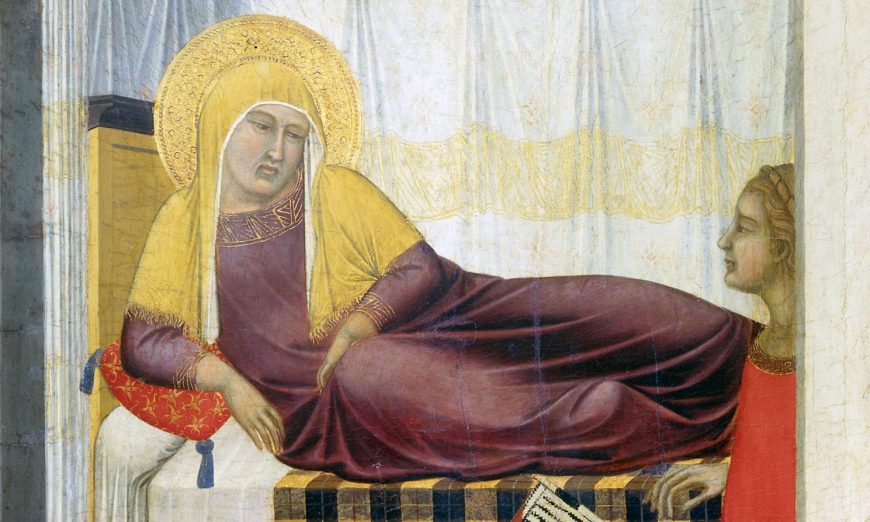
Alberti also wanted human bodies to appear anatomically correct, and the movements and facial expressions of figures to suggest their emotions. The second part of Alberti’s treatise lays out these ideals, advising painters on how to most effectively tell a story (what he calls an istoria, or narrative) in their art using variety in figure types and gestures. Alberti wanted viewers to be able to relate to the stories portrayed in art and to empathize with painted characters, but he also wanted paintings to present an idealized vision of human behavior. In Ghirlandaio’s scene, women stand, kneel, or sit. Two women in the background lean toward one another to embrace. We also see how Ghirlandaio paints women looking in different directions to create a sense that they are interacting with one another, offering viewers a more compelling narrative than simply showing Saint Anne reclining in bed.
Painting as a liberal art
For their own enjoyment artists should associate with poets and orators who have many embellishments in common with painters and who have a broad knowledge of many things whose greatest praise consists in the invention.
Alberti, On Painting, book 3:89
Why would Alberti go to such great lengths to talk about painting and its purpose? He wished for painting to be viewed as a liberal art, one similar to mathematics or music, rather than as manual labor. His goal was to elevate the status of painting, and painters along with it. One of the ways that he tried to prove that painting was an intellectual endeavor was to look to sources from antiquity. [2] He draws on the ideas of Roman authors such as Pliny the Elder, Quintillian, Cicero, Plutarch, and Lucian, turning to them for their discussions of ancient forms of painting and the artists who made them. He cites Pliny when talking about how artists like Praxiteles or Phidias were so skilled at painting that any work made by the Greek artists was valued more than costly materials like gold and silver. This inclusion and assumed familiarity with classical authors demonstrated his humanist learning and helped to initiate the formal transformation of the visual arts from manual skill to intellectual endeavor.
De Pictura encapsulates many of Alberti’s life pursuits. During his lifetime, he was a humanist, the author of an important architectural treatise, and a literary author who wrote plays, philosophical dialogues, and poetry in addition to working as a practicing architect and artist.
The reception of Alberti’s ideas
Despite the fame of Alberti’s ideas on painting today, this was not the case in his lifetime. Initially, On Painting was not printed—the European printing press wasn’t invented until around 1450. This means that Alberti’s ideas did not have a wide reception until later. Furthermore, renaissance artists would not have been able to read the 1435 Latin version of On Painting. Latin was the language of the educated elite, the language of the class of people who patronized art, not those who made it. It is likely that his initial intent was to share his ideas with a privileged audience, a reminder to us that artists worked at the pleasure of their wealthy employers. When he translated the text, he made it accessible to the people who might actually use his ideas directly.
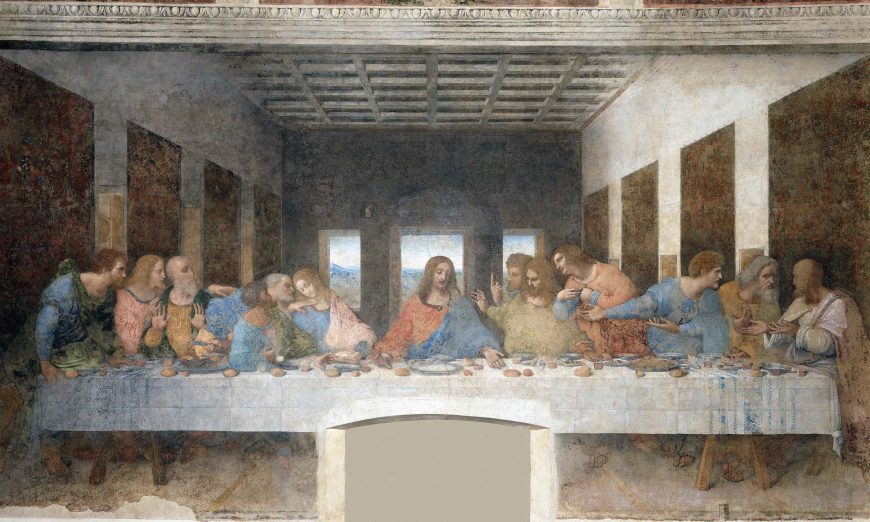
Alberti’s ideas about painting influenced later generations of artists, including the giants of high renaissance art, Leonardo da Vinci, Michelangelo, and Raphael. Even those who disagreed with Alberti’s ideas such as northern renaissance artist Albrecht Dürer, proceeded to write down their own ideas about perspective and painting.
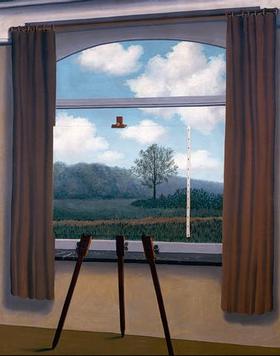
Alberti’s ideas would go on to have lasting influence on the history of art. Works of art by many early twentieth-century modern painters, such as Pablo Picasso’s Demoiselles d’Avignon, purposefully reject the illusion of deep space. They were avant-garde precisely because they challenged traditions of painting set in place since the time of Alberti. A painting like René Magritte’s The Human Condition also playfully engages with Alberti’s notion of a painting as a window through which a viewer perceives the world.
Notes:
[1] Alberti, trans. John R. Spencer, rev. ed. (1966), II:62
[2] While the Italian version differs in some respects from the Latin text, the translated work retains the classical references found throughout the Latin version.
Additional resources
Learn more about Alberti as an architect
Virtually explore the Papal Palace and the Sistine Chapel with Smarthistory as your guide
Check out Alberti’s On Painting
Linear Perspective: Brunelleschi’s Experiment
by DR. STEVEN ZUCKER and DR. BETH HARRIS
Video \(\PageIndex{4}\): An introduction to Filippo Brunelleschi’s experiment regarding linear perspective, c. 1420, in front of the Baptistry in Florence
Smarthistory images for teaching and learning:
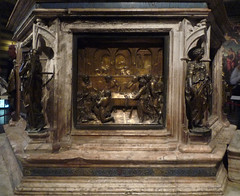
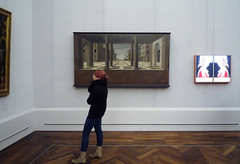
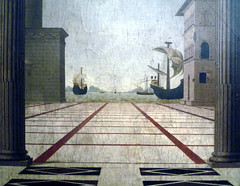
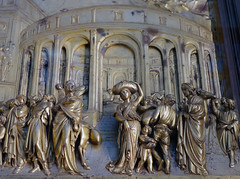
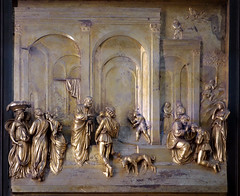

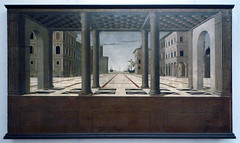
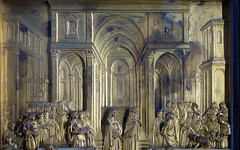
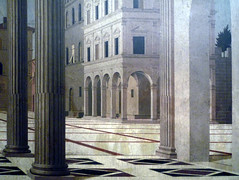
How one-point linear perspective works
by DR. STEVEN ZUCKER and DR. BETH HARRIS
Video \(\PageIndex{5}\)
Smarthistory images for teaching and learning:









Early applications of linear perspective
Representing the body
What Renaissance artists had clearly achieved through the careful observation of nature, including studies of anatomical dissections, was the means to recreate the three-dimensional physical reality of the human form on two-dimensional surfaces. In part, the key to this achievement lay in understanding the underlying, hidden structure of the human body, which enabled artists to reproduce what it was they saw in the real world on the flat surface of a wall (in the case of frescoes), or that of a wooden panel or paper (in the case of drawings and paintings).
Artists in the early fifteenth century had learned to portray the human form with faithful accuracy through careful observation and anatomical dissection. In 1420, Brunelleschi’s experiment with perspective provided a correspondingly accurate representation of physical space.
Representing space

Antonio Manetti, Brunelleschi’s biographer, writing a century later, describes the experiment based on careful mathematical calculation. It seems reasonable to assume that Brunelleschi devised the method of perspective for architectural purposes—he is said by Manetti to have made a ground plan for the Church of Santo Spirito in Florence (1434-82) on the basis of which he produced a perspective drawing to show his clients how the church would look once built. We can compare this drawing (left) with a modern photo of the actual church (below). It is clear how effective the new technique of mathematical perspective was in depicting spatial reality.

The body in space

But this was just the beginning. Ten years later, the painter Masaccio applied the new method of mathematical perspective even more spectacularly in his fresco The Holy Trinity. The barrel-vaulted ceiling is incredible in its complex, mathematical use of perspective. In this diagram, lines overlay Masaccio’s actual geometric framework to make clear the structure of the perspective system itself.

From the geometry it is actually possible to work backwards to accurately measure and reconstruct the full three-dimensional space that Masaccio depicts—illustrating Brunelleschi’s interest in being able to translate schemata directly between two- and three-dimensional spaces.
It was not long before a decisive step was taken by Leon Battista Alberti, who published a treatise on perspective, Della Pitture (or On Painting), in 1435. Once Alberti’s treatise was published, knowledge of perspective no longer had to be passed on by word of mouth. Newly codified, perspective became not just a matter of artistic interest but a philosophical concern as well.
Additional resources:
The arrow in the eye: The Psychology of Perspective and Renaissance art
Central Italy
A new realism appears in the art of central Italy in the 15th century.
1400 - 1500 (Early Renaissance)
Painting
Gentile da Fabriano
Gentile da Fabriano, Adoration of the Magi
by DR. JOANNA MILK MAC FARLAND
Video \(\PageIndex{6}\): Gentile da Fabriano, Adoration of the Magi, 1423, tempera on panel, 283 x 300 cm (Galleria degli Uffizi, Florence)

When looking at Gentile da Fabriano’s Adoration of the Magi, imagine yourself in front of it. Not standing in front of the painting in the bright Uffizi gallery, but in front of an altar in a dark sacristy, watching flickering candlelight dance on layers of silver, gold and paint that have been molded, incised, and glazed into glittering textures. The effect would be overwhelming. Only after this visual shock would you begin to look more closely, wondering what the painting is actually about, who could have painted such a thing, and—perhaps just as importantly for the Renaissance viewer—who could have possibly afforded it. The answers to these questions are complex and intertwined. Yet, with a little historical context, they can be found in the painting itself.

An altarpiece fit for kings
The altarpiece depicts several Gospel stories surrounding the birth of Christ as they were retold in the Middle Ages and Renaissance. In the main panel, three Magi (wise men and kings believed to come from unknown, eastern lands) offer gifts to the newly born Christ child. Their adventure begins in the background: smaller scenes of the Magi fill an extraordinary landscape in the three arches above, allowing us to follow their journey in a cartoon-like, continuous narrative.


At far left, they climb a mountain in search of the star they believed would fulfill an ancient prophecy telling of a great king. Following this star, the magi lead their impressive retinue to Jerusalem, shown at the top center of the painting (see image above), and then to the smaller town of Bethlehem at the upper right corner.
The main action of the panel then unfolds in the foreground, where the Magi finally arrive at the small cave where Joseph and Mary have been forced to take shelter with their newborn child. Haloed and resplendent, each king takes his turn offering a gift of gold, frankincense, or myrrh, removing his crown, and kissing the foot of the tiny baby.
As in earlier images of the Magi, they are accompanied by large numbers of courtiers and attendants on horseback as if they were emissaries from a foreign country. More than previous artists, Gentile used the journey of the Magi as an opportunity to flaunt his visual imagination and technical skill. The ‘kings’ do not wear ancient clothing, as one might expect from a biblical story, but imaginative costumes designed to look luxurious and vaguely exotic. The royal retinue is bursting with varied figure types, intricately patterned brocades, and rare animals. Foreground figures are almost stacked on top of one another, as if the ground is tilted forward in order to fill a limited space with a maximum number of figures. Such decorative opulence is continued in the ornate, three-arched frame.

The altarpiece is not just visually busy, but also rich with narrative detail. The dog in the right foreground looks up in fear toward a horse that is about to carelessly step on him. At far left, two female attendants curiously (and somewhat rudely) inspect the precious gift the elderly king has already presented to the holy family.
Even the background includes stories-within-stories. Look for a lonely traveler being accosted by thieves, or for a leopard preparing to pounce toward a local deer he has just spotted from his seat on the back of a horse. These anecdotal, even humorous incidents invite the viewer to inspect each area of the painting carefully, discovering something new at each turn.
From Fabriano to Florence
This was the sort of visual abundance at which Gentile da Fabriano excelled. The artist’s impressive skills were nurtured during his travels to artistic centers throughout Italy. As his name suggests, Gentile was from the town of Fabriano, over a hundred miles southeast of Florence. Years spent in the northern towns of Venice and Brescia in particular encouraged his love of courtly ornamentation and an interest in the close observation of plants and animals. These sojourns also helped build his reputation, and his arrival in Florence by 1422 at the height of his powers would have caused quite the tizzy among the city’s artists and the elite families who patronized them.

At the time, Florence was awash with creativity—a crucible of varying artistic styles. In the works of Lorenzo Monaco, the most successful Florentine painter in these years, an infusion of curving, northern European forms enlivened the inherited tradition of the previous century.
New directions were being pioneered in the practice of sculpture and architecture: Brunelleschi had just conducted his now famous experiment in perspective and the sculptor Donatello helped to revive a taste for classicizing figures and illusionistic depictions of space. The young Masaccio was a scant few years away from changing the history of art by exploring these innovations through the medium of painting.
Palla Strozzi
Into this moment of visual experimentation and change stepped Gentile da Fabriano, a virtual artistic celebrity throughout Italy and beyond. He soon received a prime opportunity to demonstrate his abilities to the city: a prestigious commission from Florence’s wealthiest citizen, Palla Strozzi. Strozzi spent an unprecedented sum on the building and decoration of his family’s chapel in the sacristy of the church of Santa Trinità. Sometime before 1423, the banker turned to Gentile for an altarpiece as part of this project. The Adoration of the Magi represents the result of this commission, showing us that Gentile knew just how to dazzle an expectant audience.

Although we are not sure why a scene of the Adoration was chosen for the painting, it seems likely that Palla saw the subject as an opportunity to display his status in other ways.
The courtly retinue of Gentile’s painting reminded viewers of Palla’s diplomatic credentials: the banker had travelled as a member of official Florentine visits to various cities throughout Italy. He even had himself depicted as one the Magi’s courtiers. Just behind the third king, he stands holding a falcon—a reference to his family, since strozzieri was the Tuscan word for “falconer” (left).
Other personalized symbols are cleverly included in the painting. The bridle on the white horse to the far right, for example, is decorated with a crescent moon, the central feature on the Strozzi coat-of-arms.

A different kind of naturalism

Gentile’s altarpiece visually announced the amount of gold his patron could purchase and the caliber of artist he could afford to hire. But it also displayed Palla’s cultivated taste for the new and daring. For all of its apparent preoccupation with wealth and worldly status, the Adoration celebrated nature in a way that few paintings had before. People, animals and their movements are carefully observed. Flowers seem to burst forth from the pillars that bracket the frame (see detail above). The subtle modeling of figures’ faces is quite different from the stark contours seen in paintings by popular Florentine artists such as Lorenzo Monaco. And Florentine viewers would surely have noted how fur and fabric were depicted using softer brush strokes than those they were used to seeing. More remarkably, the scenes within this complex structure create a sort of visual dissertation on different kinds of light and shadow. In the main scene, the famous star of Bethlehem illuminates surrounding trees, gilding the edges of their leaves and casting intricate shadows behind the heads of the maids at left.
The small panels below the main scene (a supporting structure known as a predella) are even more experimental in their depiction of different kinds of lighting. The Nativity (image below) is imagined as a night scene with multiple sources of light: the supernatural radiance emanating from the small Christ Child, the brightness of the angel appearing to shepherds in the background, and the much softer glow of the moon at top left.

In the middle predella panel, the new family flees to Egypt against a landscape bathed in the blazing midday sun – a raised golden orb amid a blue sky showering the nearest hillsides in gold. The last panel shows Christ’s presentation in the temple, the building’s dark interior warmly lit by a wall lamp at its center.

Gentile used real gold to achieve many of these subtle lighting effects, demonstrating his ability to combine intricate manipulation of precious materials with an interest in naturalism. Perfecting a technique that would be copied by many other artists, he layered gold leaf underneath layers of paint to lend brightly lit surfaces an added glow—an effect that would be more readily apparent in candlelight. This means precious metals are woven underneath the surface, on the surface, and protruding from the surface, like a tapestry made of paint and gold.
Looking again
To the modern viewer, Gentile’s Adoration may seem too busy, too ornate and too crowded. Even art historians have sometimes had difficulties looking past its emphasis on patterning and flattened space to see how this painting and other works by Gentile contributed to the flowering of the arts in Early Renaissance Florence. Yet the altarpiece’s very richness helped to insure its influence, allowing artists to draw different lessons from Gentile’s painting techniques and visual interests. These contemporary viewers likely understood what present-day visitors to the Uffizi might forget: that the Adoration was not designed to be taken in at a single glance. If we remember this and try to look at the image the way it was meant to be looked at—again and again—it will reward each viewing.
Gentile da Fabriano, Adoration of the Magi (reframed)
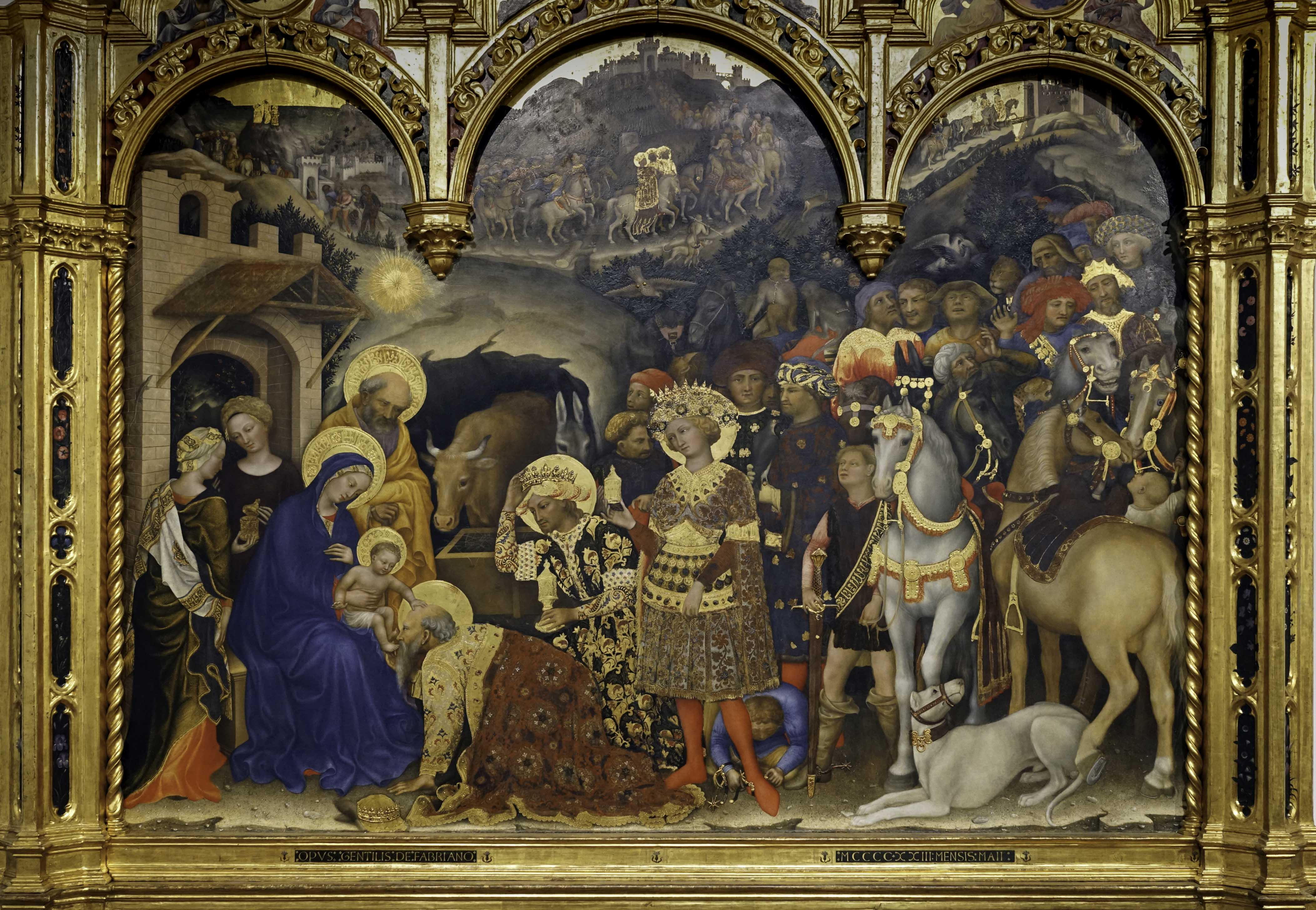
After Jesus was born in Bethlehem in Judea, during the time of King Herod, Magi from the east came to Jerusalem 2 and asked, “Where is the one who has been born king of the Jews? We saw his star when it rose and have come to worship him.” […] 10 When they saw the star, they were overjoyed. 11 On coming to the house, they saw the child with his mother Mary, and they bowed down and worshiped him. Then they opened their treasures and presented him with gifts of gold, frankincense and myrrh.
Matthew 2:1-2, 10-11, NIV
The journey of the wise men
Brilliant golden brocades. Psuedo-Arabic. Turbans. Leopards and lions. Gentile da Fabriano’s Adoration of the Magi creates a dynamic visual narrative of the journey of the Magi to Bethlehem recounted in the Gospel of Matthew. The painting uses continuous narrative to show us the moment the Magi first see the star announcing Jesus’ birth, their journey to Jerusalem, and then subsequent arrival in Bethlehem where they meet the infant Jesus. Three golden arches (forming part of the elaborate frame) differentiate the three narrative moments, although the final moment—when they arrive at the cave in Bethlehem where Mary, Joseph, and Jesus rest—spills across the foreground.
Here the Magi take turns kneeling before Jesus and presenting him with gifts (of gold, frankincense, and myrrh). In Gentile’s painting, the oldest Magi (eventually known as Melchior) is kissing Jesus’ foot, as the Christian messiah (Jesus) touches his head. The other two Magi (Caspar, middle aged; and Balthazar, young) prepare to do the same, holding their gifts aloft. All three Magi are elaborately dressed, and each one has a golden crown.
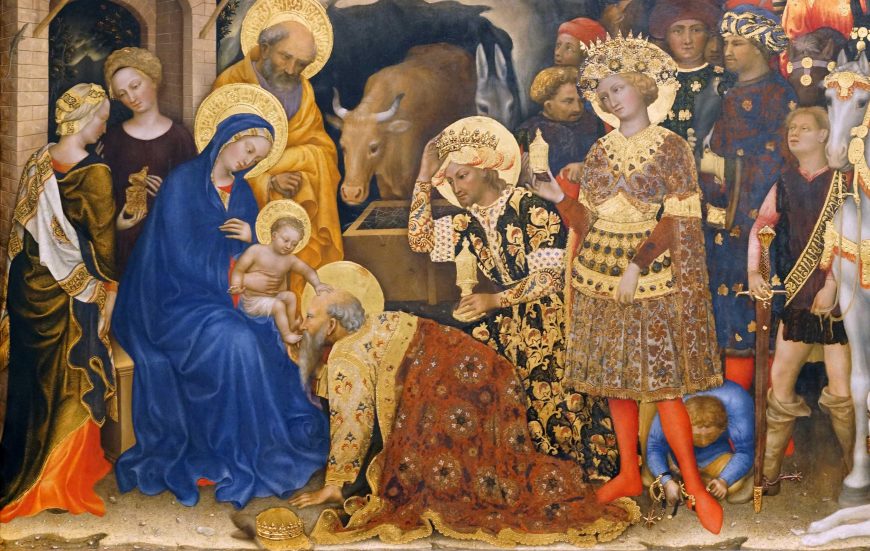
The Magi were thought to be from east of Europe (though the specific origins of each Magi are not noted in the Bible). By the later Middle Ages, the Magi were understood as standing in for the world, with each of them coming from Asia, Africa, and even Europe. By the fifteenth century, when Gentile was working, this image of a more globalized array of Magi had been widely adopted. It provided a lavish sense of different places, and allowed artists to show a variety of exotic luxury goods. It also helped to give the impression of a united world under God.
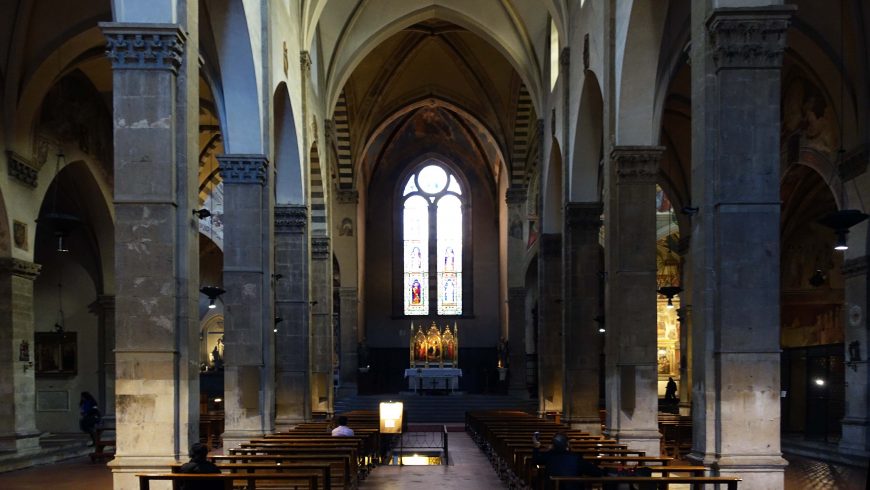
Commissioned by Palla Strozzi, a wealthy banker and merchant, for his family’s chapel for the Florentine church of Santa Trinità, the Adoration of the Magi speaks to the global flow of goods at this time, visual transculturation, as well as the European conceptualization of non-European places and peoples.
Psuedo-Arabic
The haloes around the Madonna and Joseph are a brilliant gold, emphasizing their holiness. If we look closely at them, we notice the haloes also include what appears to be writing. This script is actually psuedo-Arabic—a script that approximates Arabic writing, but is not entirely correct. It suggests that the artist could not actually read Arabic; that said, he does include Arabic words as well. The haloes also include decorative rosettes separating each word. Psuedo-Arabic script doesn’t only appear on Mary’s and Joseph’s haloes either. The young page, standing next to the white horse in the foreground, wears a sash written in the script. One of the female figures behind Mary, whose back is turned to us, wears a white shawl decorated with pseudo-Arabic writing. The sleeves of the youngest Magi suggest the script as well, written at the elbow. Here Gentile seems to write the word al-‘ādilī (The Just).[1]
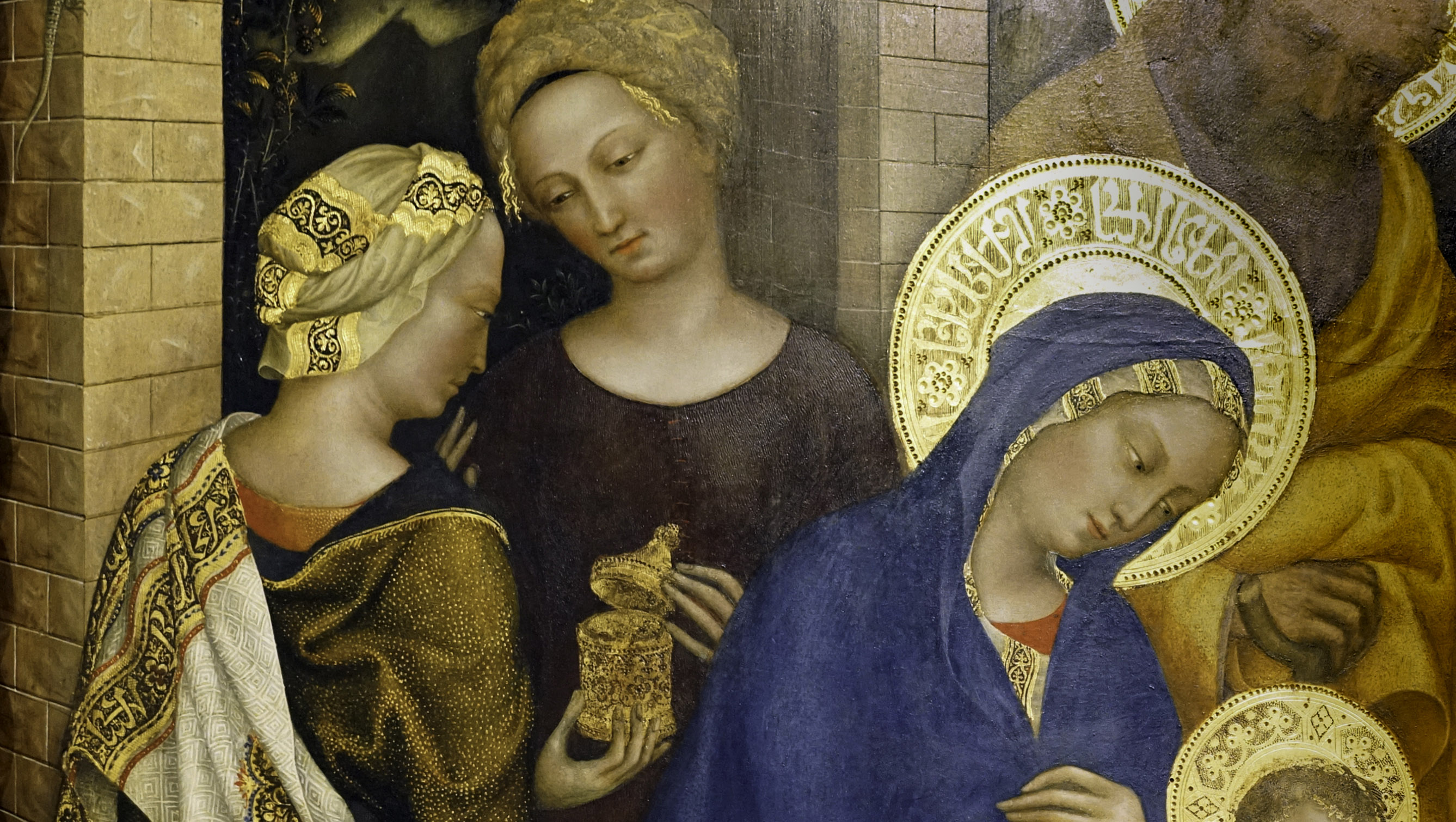
But why would the artist include psuedo-Arabic in one of the holiest scenes from the life of Jesus? One possible reason is that other Italian artists similarly included psuedo-Arabic into their paintings—often on haloes or textiles—and Gentile was continuing this tradition. We find examples in the paintings of Duccio, Giotto, and Masaccio, and in sculptures like Verocchio’s David and Filarete’s doors for the Vatican. Gentile incorporated pseudo-Arabic into other paintings, such as his Madonna of the Humility (c. 1420) and Coronation of the Virgin (c.1420). It is likely more complicated than Gentile solely copying other artists however.
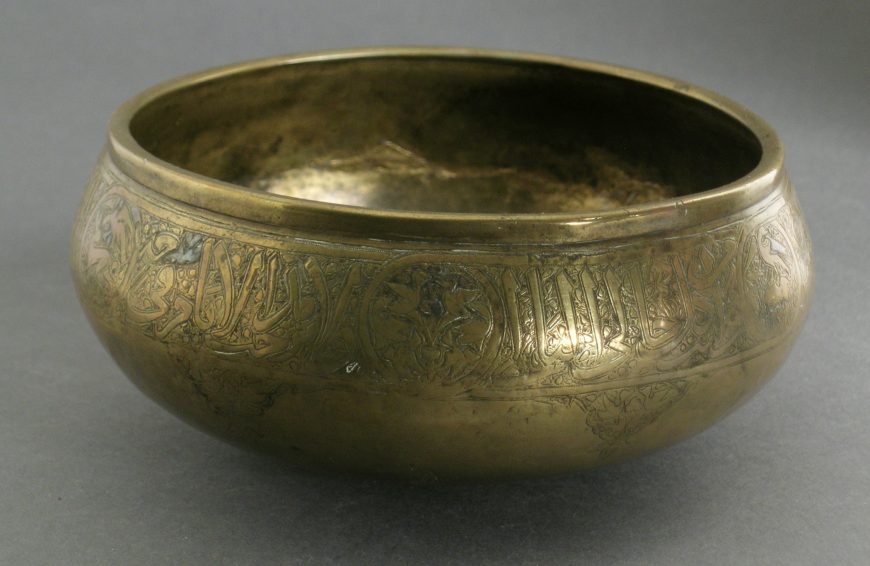
It seems that artists like Gentile borrowed motifs and stylistic patterns from Ayyubid or Mamluk metalwork and textiles that they encountered first hand. These were highly coveted luxury objects and materials, and wealthy families—like the Strozzi—often owned examples. The city of Florence also had made several diplomatic missions to important Muslim trade areas, including one in 1421 to Tunis and another in 1422–23 to Cairo. They established a commercial treaty with the Mamluk sultan in Egypt, and opened a direct trade route to Alexandria via Pisa (which Florence captured in 1406) and Livorno (controlled by Florence after 1421). It has been suggested that these commercial ties may have stimulated even greater interest in luxury objects, like Mamluk brass objects, and the decorative schema found on them.
A third possible reason is that pseudo-Arabic connoted sacredness in some way. The city of Jerusalem (and the Holy Lands more generally) is in the eastern Mediterranean and in the fourteenth and fifteenth centuries these areas were controlled by Muslim rulers. Perhaps the use of Arabic script was a way for artists like Giotto and Gentile da Fabriano to reference the Holy Lands within their paintings, or even to suggest the common heritage of Islam and Christianity.
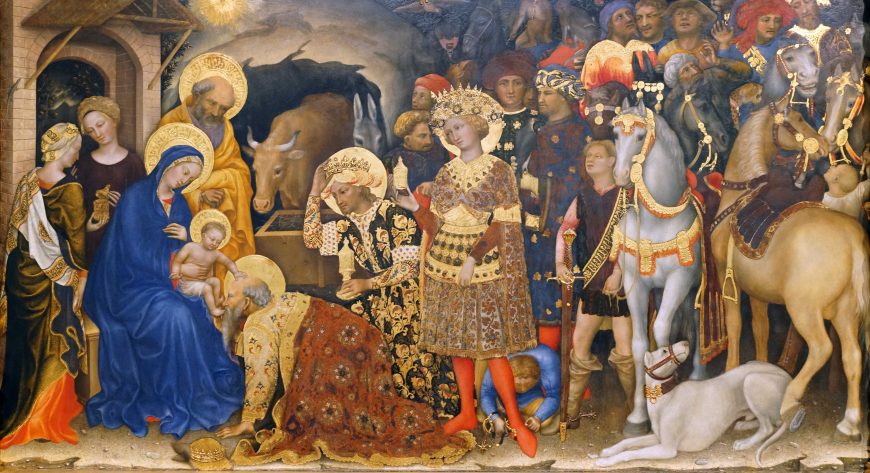
Wearing signs of “the east”
Besides the use of psuedo-Arabic, other elements of the painting point to Gentile’s desire to call to mind “the east” and the exotic sense of the Holy Lands. Multiple figures in the painting wear turbans, a common visual sign that indicated someone from outside Christian Europe, typically someone of Middle Eastern descent. Caspar, the second Magi, wears one. They are used here to suggest the Holy Lands once again, as well as the eastern or non-European origins of some of the Magi. After all, the journey of the Magi takes them to Jerusalem and onto Bethlehem, and so the turban here communicates that the scene is outside of Christian territory, in a more exotic location.
Besides turbans, we also find figures, such as the Magi, wearing elaborate brocades, damasks, other silks, and velvets. Melchior wears a patterned garment of pearlescent white with golden accents, and above that a mantle of burnt siena accented with gold and silver. On both, rosettes and other floral designs animate the surface. Caspar wears a long tunic in black decorated with golden pomegranates.
While the pomegranate was a prominent Christian symbol of rebirth, it was also common as a symbol of its eastern origins and it was a popular motif in Muslim textiles as well. Gentile also includes pomegranate trees in the painting to connote Jerusalem’s and Bethlehem’s eastern locales. Balthazar’s outfit is similarly elaborate. His abdomen is covered in golden designs that almost mimic peacock feathers. His long and elaborate sleeves extend to his knees, and are enlivened by reddish flowers scrolling across the surface. Golden and silver fringe can be found on the edges of his entire outfit.
The exact origins of these textiles is difficult to pinpoint but they all evoke “eastern” patterns and textiles. They could have been acquired by trade from Muslim merchants, or produced in Italy. Cities like Venice, Genoa, and Florence became skilled centers of silk production, and their designs often mimic Muslim textile patterns. Such clothing (whether acquired from afar or made in Italy), was expensive, and was highly sought after by elites. The ornate appearance of the Magi’s clothes in Gentile’s painting does seem to suggest that they are men “from the east.”
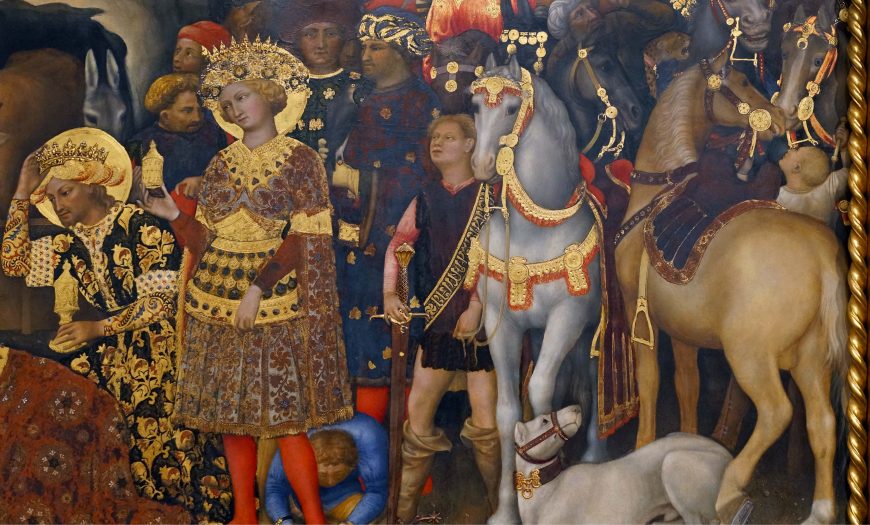
An exotic menagerie
As if the painting wasn’t already a feast for the eyes, Gentile has also included a number of non-European or exotic animals into the riotous scene. Two monkeys sit atop a camel. We also find a lion eyeing two birds, and further below a leopard (or possible cheetah) amidst the tightly packed group of men. Animals from outside Europe (Asia, Africa, and eventually the Americas after 1492) were a constant source of interest for Europeans. They were collected, given as gifts, and sometimes even trained to join in courtly hunting expeditions.
Falcons were not necessarily an exotic predatory bird, but falconry had been heavily influenced by Arabian/Muslim traditions. Falcons were especially associated with Persian culture. New falcons acquired from distant lands also appealed to Italian elites. The man holding the falcon is possible a member of the Strozzi family (possibly Palla, the patron) because the Italian word for falconer is strozziere.
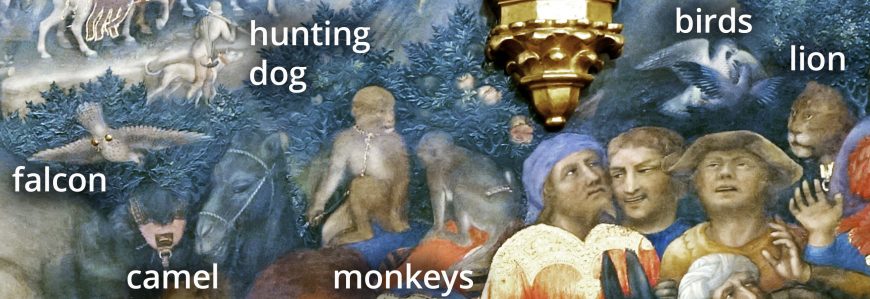
Wealthy individuals sometimes acquired exotic animals as a sign of their wealth and their interest in the natural world. Monkeys and apes were popular collectibles, and here they wear collars so as not to escape. Large cats, like the leopard and lion, were sometimes kept and trained for hunting, especially among the northern Italian courts. Exotic animals like camels were popular gifts.
The non-European animals in the painting also help to set the scene in a more exoticized eastern location. The horses are likely Arabian horses, acquired from Muslim trading partners. The camel’s associations with the Holy Lands are mentioned in the Bible. While there is no peacock displayed in the painting, one man does wear a hat/headdress made of its feathers. The peacock, as a symbol of resurrection, dated back to antiquity. Peafowl came from Asia, namely India, and the man’s headgear helps to further associate his eastern origins.
And of course, some of these exotic animals had symbolic meaning that played a role in the painting. Matthew 19:24 famously notes that it is easier for a camel to pass through the eye of a needle than for a rich man to enter the kingdom of heaven. Here, it might symbolically remind wealthy viewers, like the Strozzi, of this warning.
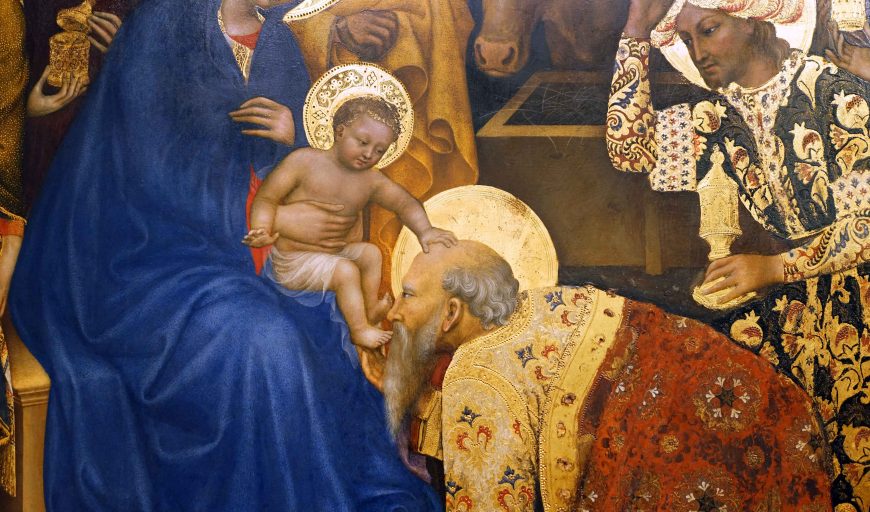
Material brilliance
The two most expensive materials used in this painting are lapis lazuli and gold. The Virgin Mary’s robe is ultramarine, or a brilliant blue color derived from lapis lazuli. It came from mines in Afghanistan. It could only be mined five months out of the year too, increasing its monetary worth. At this time in the Renaissance, it was more valuable than gold. This is why artists like Gentile often reserved it for Mary’s mantle, using other blue pigments throughout the remainder of the painting.
Gold was also expensive, and Gentile has used a lot of it here. Palla Strozzi, wanting to advertise his wealth, would surely have been thrilled by the lavish use of the gold across the surface. Most gold came from west Africa, traded along caravan routes. Mali, which at one point had been ruled by the powerful and wealthy Musa Keita I (known as Mansa Musa in Europe) reputedly had an enormous amount of gold. When Musa Keita I traveled to Mecca on the hajj between 1324 and 1325 he flooded the market with gold and caused an economic collapse because the price of gold fell steeply.
Gentile doesn’t just incorporate gold into his painting, he uses a technique to suggest an even greater abundance of the precious metal. He uses pastiglia, or raised gilt ornament, which we see on the crowns, swords, spurs, and even on some textiles. It gives these golden areas a three-dimensional quality because they are raised from the flat surface of the painting. Imagine the shimmering quality of all this gold and other material magnificence in the flickering candlelight of the Strozzi chapel!
[1] Ennio G. Napolitano, Arabic Inscriptions and Pseudo-Inscriptions in Italian Art (PhD dissertation, Otto-Friedrich-Universität, Bamberg), p. 99.
Additional resources
Anna Contadini, “Sharing a Taste? Material Culture and Intellectual Curiosity around the Mediterranean, from the Eleventh to the Sixteenth Century,” in The Renaissance and Ottoman World, ed. Anna Contadini and Claire Norton (London: Ashgate, 2013), 24–61.
Rosamund E. Mack, Bazaar to Piazza: Islamic Trade and Italian art, 1300–1600 (Berkeley, CA: University of California Press, 2002).
Alexander Nagel, “Twenty-five notes on pseudoscript in Italian art,” RES: Journal of Anthropology and Aesthetics, vol. 59/60 (Spring/Autumn 2011), pp. 229–248.
Patricia Lee Rubin, Images and Identity in Fifteenth-century Florence (New Haven and London:Yale University Press, 2007).
Masaccio
Masaccio, Virgin and Child Enthroned
by DR. BETH HARRIS and DR. STEVEN ZUCKER
Video \(\PageIndex{7}\): Masaccio (Tommaso di Ser Giovanni di Simone), Virgin and Child Enthroned, 1426, tempera on panel (National Gallery, London)
Ser Giuliano degli Scarsi, a notary from Pisa, commissioned this altarpiece for the chapel of Saint Julian in Santa Maria del Carmine, Pisa.
Masaccio, Holy Trinity
by DR. STEVEN ZUCKER and DR. BETH HARRIS
Video \(\PageIndex{8}\): Masaccio, Holy Trinity, c. 1427, fresco, 667 x 317 cm, Santa Maria Novella, Florence

Masaccio was the first painter in the Renaissance to incorporate Brunelleschi’s discovery, linear perspective, in his art. He did this in his fresco the Holy Trinity, in Santa Maria Novella, in Florence.
Have a close look at the painting and at this perspective diagram. The orthogonals can be seen in the edges of the coffers in the ceiling (look for diagonal lines that appear to recede into the distance). Because Masaccio painted from a low viewpoint, as though we were looking up at Christ, we see the orthogonals in the ceiling, and if we traced all of the orthogonals, we would see that the vanishing point is on the ledge that the donors kneel on.
God’s feet
Our favorite part of this fresco is God’s feet. Actually, you can only really see one of them.

God is standing in this painting. This may not strike you all that much when you first think about it because our idea of God, our picture of God in our minds eye—as an old man with a beard—is very much based on Renaissance images of God. So, here Masaccio imagines God as a man. Not a force or a power, or something abstract, but as a man. A man who stands—his feet are foreshortened, and he weighs something and is capable of walking. In medieval art, God was often represented by a hand, as though God was an abstract force or power in our lives—but here he seems so much like a flesh and blood man. This is a good indication of Humanism in the Renaissance.

Masaccio’s contemporaries were struck by the palpable realism of this fresco, as was Vasari who lived over one hundred years later. Vasari wrote that “the most beautiful thing, apart from the figures, is a barrel-shaped vaulting, drawn in perspective and divided into squares filled with rosettes, which are foreshortened and made to diminish so well that the wall appears to be pierced.”¹
The architecture
One of the other remarkable things about this fresco is the use of the forms of classical architecture (from ancient Greece and Rome). Masaccio borrowed much of what we see from ancient Roman architecture, and may have been helped by the great Renaissance architect Brunelleschi.
Coffers – the indented squares on the ceiling
Column – a round, supporting element in architecture. In this fresco by Masaccio we see an attached column
Pilasters – a shallow, flattened out column attached to a wall—it is only decorative, and has no supporting function
Barrel Vault – vault means ceiling, and a barrel vault is a ceiling in the shape of a round arch
Ionic and Corinthian Capitals – a capital is the decorated top of a column or pilaster. An ionic capital has a scroll shape (like the ones on the attached columns in the painting), and a Corinthian capital has leaf shapes.
Fluting – the vertical, indented lines or grooves that decorated the pilasters in the painting—fluting can also be applied to a column

1. Vasari, “Masaccio” in Lives of the Most Excellent Painters, Sculptors, and Architects the Artists (first published in 1550 in Italian)
Video \(\PageIndex{9}\)
Additional resources:
Masaccio, The Tribute Money in the Brancacci Chapel
by DR. STEVEN ZUCKER and DR. BETH HARRIS
Video \(\PageIndex{10}\): Masaccio, The Tribute Money, 1427, fresco (Brancacci Chapel, Santa Maria del Carmine, Florence)

The Tribute Money is one of many frescoes painted by Masaccio (and another artist named Masolino) in the Brancacci chapel in Santa Maria del Carmine in Florence—when you walk into the chapel, the fresco is on your upper left. All of the frescoes in the chapel tell the story of the life of St. Peter. The story of the Tribute Money is told in three separate scenes within the same fresco. This way of telling an entire story in one painting is called a continuous narrative.
A story unfolds and a miracle is performed


In the Tribute Money, a Roman tax collector (the figure in the foreground in a short orange tunic and no halo) demands tax money from Christ and the twelve apostles who don’t have the money to pay.
Christ (in the center, wearing a pinkish robe gathered in at the waist, with a blue toga-like wrap) points to the left, and says to Peter “so that we may not offend them, go to the lake and throw out your line. Take the first fish you catch; open its mouth and you will find a four-drachma coin. Take it and give it to them for my tax and yours” (Matthew 17:27). Christ performed a miracle—and the apostles have the money to pay the tax collector. In the center of the fresco (scene 1), we see the tax collector demanding the money, and Christ instructing Peter. On the far left (scene 2), we see Peter kneeling down and retrieving the money from the mouth of a fish, and on the far right (scene 3), St. Peter pays the tax collector. In the fresco, the tax collector appears twice, and St. Peter appears three times (you can find them easily if you look for their clothing).
We are so used to one moment appearing in one frame (think of a comic book, for example) that the unfolding of the story within one image (and out of order!) seems very strange to us. But with this technique (a continuous narrative)—which was also used by the ancient Romans—Masaccio is able to make an entire drama unfold on the wall of the Brancacci chapel.

In the central, first scene, the tax collector points down with his right hand, and holds his left palm open, impatiently insisting on the money from Christ and the apostles. He stands with his back to us, which helps to create an illusion of three dimensional space in the image (a goal which was clearly important to Masaccio as he also employed both linear and atmospheric perspective to create an illusion of space). Like Donatello’s St. Mark from Orsanmichele in Florence, he stands naturally, in contrapposto, with his weight on his left leg, and his right knee bent. The apostles (Christ’s followers) look worried and anxiously watch to see what will happen. St. Peter (wearing a large deep orange colored toga draped over a blue shirt) is confused, as he seems to be questioning Christ and pointing over to the river, but he also looks like he is willing to believe Christ.

The gestures and expressions help to tell the story. Peter seems confused and points to the lake—mirroring Christ’s gesture; the tax collector looks upset, and has his hand out insistently asking for the money—he stands in contrapposto with his back turned to us (contrapposto is a standing position, where the figure’s weight is shifted to one leg). Only Christ is completely calm because he is performing a miracle.

Look down at the feet—how the light travels through the figures, and is stopped when it encounters the figures. The figures cast shadows—Masaccio is perhaps the first artist since classical antiquity to paint cast shadows. What this does is make the fresco so much more real—it is as if the figures are truly standing out in a landscape, with the light coming from one direction, and the sun in the sky, hitting all the figures from the same side and casting shadows on the ground. For the first time since antiquity, there is almost a sense of weather.
Additional resources:
Masaccio, the Old Master who died young (The Guardian)
The Magic of Illusion: Masaccio’s Holy Trinity, from the National Gallery of Art
Smarthistory images for teaching and learning:
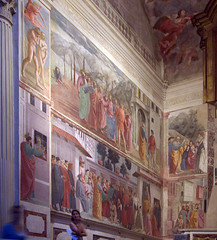
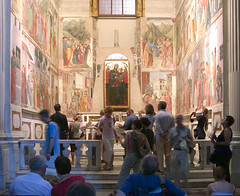
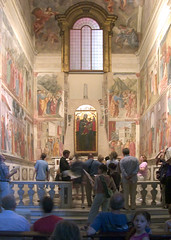
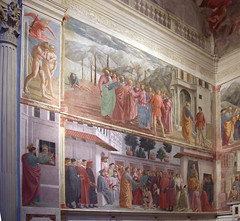
Masaccio, Holy Trinity
by DR. STEVEN ZUCKER and DR. BETH HARRIS
Video \(\PageIndex{8}\): Masaccio, Holy Trinity, c. 1427, fresco, 667 x 317 cm, Santa Maria Novella, Florence

Masaccio was the first painter in the Renaissance to incorporate Brunelleschi’s discovery, linear perspective, in his art. He did this in his fresco the Holy Trinity, in Santa Maria Novella, in Florence.
Have a close look at the painting and at this perspective diagram. The orthogonals can be seen in the edges of the coffers in the ceiling (look for diagonal lines that appear to recede into the distance). Because Masaccio painted from a low viewpoint, as though we were looking up at Christ, we see the orthogonals in the ceiling, and if we traced all of the orthogonals, we would see that the vanishing point is on the ledge that the donors kneel on.
God’s feet
Our favorite part of this fresco is God’s feet. Actually, you can only really see one of them.

God is standing in this painting. This may not strike you all that much when you first think about it because our idea of God, our picture of God in our minds eye—as an old man with a beard—is very much based on Renaissance images of God. So, here Masaccio imagines God as a man. Not a force or a power, or something abstract, but as a man. A man who stands—his feet are foreshortened, and he weighs something and is capable of walking. In medieval art, God was often represented by a hand, as though God was an abstract force or power in our lives—but here he seems so much like a flesh and blood man. This is a good indication of Humanism in the Renaissance.

Masaccio’s contemporaries were struck by the palpable realism of this fresco, as was Vasari who lived over one hundred years later. Vasari wrote that “the most beautiful thing, apart from the figures, is a barrel-shaped vaulting, drawn in perspective and divided into squares filled with rosettes, which are foreshortened and made to diminish so well that the wall appears to be pierced.”¹
The architecture
One of the other remarkable things about this fresco is the use of the forms of classical architecture (from ancient Greece and Rome). Masaccio borrowed much of what we see from ancient Roman architecture, and may have been helped by the great Renaissance architect Brunelleschi.
Coffers – the indented squares on the ceiling
Column – a round, supporting element in architecture. In this fresco by Masaccio we see an attached column
Pilasters – a shallow, flattened out column attached to a wall—it is only decorative, and has no supporting function
Barrel Vault – vault means ceiling, and a barrel vault is a ceiling in the shape of a round arch
Ionic and Corinthian Capitals – a capital is the decorated top of a column or pilaster. An ionic capital has a scroll shape (like the ones on the attached columns in the painting), and a Corinthian capital has leaf shapes.
Fluting – the vertical, indented lines or grooves that decorated the pilasters in the painting—fluting can also be applied to a column

1. Vasari, “Masaccio” in Lives of the Most Excellent Painters, Sculptors, and Architects the Artists (first published in 1550 in Italian)
Video \(\PageIndex{9}\)
Additional resources:
Masaccio, The Tribute Money in the Brancacci Chapel
by DR. STEVEN ZUCKER and DR. BETH HARRIS
Video \(\PageIndex{10}\): Masaccio, The Tribute Money, 1427, fresco (Brancacci Chapel, Santa Maria del Carmine, Florence)

The Tribute Money is one of many frescoes painted by Masaccio (and another artist named Masolino) in the Brancacci chapel in Santa Maria del Carmine in Florence—when you walk into the chapel, the fresco is on your upper left. All of the frescoes in the chapel tell the story of the life of St. Peter. The story of the Tribute Money is told in three separate scenes within the same fresco. This way of telling an entire story in one painting is called a continuous narrative.
A story unfolds and a miracle is performed


In the Tribute Money, a Roman tax collector (the figure in the foreground in a short orange tunic and no halo) demands tax money from Christ and the twelve apostles who don’t have the money to pay.
Christ (in the center, wearing a pinkish robe gathered in at the waist, with a blue toga-like wrap) points to the left, and says to Peter “so that we may not offend them, go to the lake and throw out your line. Take the first fish you catch; open its mouth and you will find a four-drachma coin. Take it and give it to them for my tax and yours” (Matthew 17:27). Christ performed a miracle—and the apostles have the money to pay the tax collector. In the center of the fresco (scene 1), we see the tax collector demanding the money, and Christ instructing Peter. On the far left (scene 2), we see Peter kneeling down and retrieving the money from the mouth of a fish, and on the far right (scene 3), St. Peter pays the tax collector. In the fresco, the tax collector appears twice, and St. Peter appears three times (you can find them easily if you look for their clothing).
We are so used to one moment appearing in one frame (think of a comic book, for example) that the unfolding of the story within one image (and out of order!) seems very strange to us. But with this technique (a continuous narrative)—which was also used by the ancient Romans—Masaccio is able to make an entire drama unfold on the wall of the Brancacci chapel.

In the central, first scene, the tax collector points down with his right hand, and holds his left palm open, impatiently insisting on the money from Christ and the apostles. He stands with his back to us, which helps to create an illusion of three dimensional space in the image (a goal which was clearly important to Masaccio as he also employed both linear and atmospheric perspective to create an illusion of space). Like Donatello’s St. Mark from Orsanmichele in Florence, he stands naturally, in contrapposto, with his weight on his left leg, and his right knee bent. The apostles (Christ’s followers) look worried and anxiously watch to see what will happen. St. Peter (wearing a large deep orange colored toga draped over a blue shirt) is confused, as he seems to be questioning Christ and pointing over to the river, but he also looks like he is willing to believe Christ.

The gestures and expressions help to tell the story. Peter seems confused and points to the lake—mirroring Christ’s gesture; the tax collector looks upset, and has his hand out insistently asking for the money—he stands in contrapposto with his back turned to us (contrapposto is a standing position, where the figure’s weight is shifted to one leg). Only Christ is completely calm because he is performing a miracle.

Look down at the feet—how the light travels through the figures, and is stopped when it encounters the figures. The figures cast shadows—Masaccio is perhaps the first artist since classical antiquity to paint cast shadows. What this does is make the fresco so much more real—it is as if the figures are truly standing out in a landscape, with the light coming from one direction, and the sun in the sky, hitting all the figures from the same side and casting shadows on the ground. For the first time since antiquity, there is almost a sense of weather.
Additional resources:
Masaccio, the Old Master who died young (The Guardian)
The Magic of Illusion: Masaccio’s Holy Trinity, from the National Gallery of Art
Smarthistory images for teaching and learning:




Masaccio, Expulsion of Adam and Eve from Eden in the Brancacci Chapel
by DR. STEVEN ZUCKER and DR. BETH HARRIS
Video \(\PageIndex{11}\): Masaccio, Expulsion of Adam and Eve from Eden, Brancacci Chapel, Santa Maria del Carmine, Florence, Italy, c. 1424-27, fresco, 7 feet x 2 feet 11 inches
Smarthistory images for teaching and learning:




Fra Angelico
Fra Angelico, The Annunciation and Life of the Virgin (c. 1426)
by DR. BETH HARRIS and DR. STEVEN ZUCKER
Video \(\PageIndex{12}\): Fra Angelico, The Annunciation and Life of the Virgin (in the predella), c. 1426, tempera on wood, 194 x 194 cm (Museo del Prado, Madrid)
The Annunciation is described in the Gospel According to Luke 1:26 – 38. Here is the King James translation:
And in the sixth month the angel Gabriel was sent from God unto a city of Galilee, named Nazareth, To a virgin espoused to a man whose name was Joseph, of the house of David; and the virgin’s name [was] Mary. And the angel came in unto her, and said, Hail, [thou that art] highly favoured, the Lord [is] with thee: blessed [art] thou among women. And when she saw [him], she was troubled at his saying, and cast in her mind what manner of salutation this should be. And the angel said unto her, Fear not, Mary: for thou hast found favour with God. And, behold, thou shalt conceive in thy womb, and bring forth a son, and shalt call his name JESUS. He shall be great, and shall be called the Son of the Highest: and the Lord God shall give unto him the throne of his father David: And he shall reign over the house of Jacob for ever; and of his kingdom there shall be no end. Then said Mary unto the angel, How shall this be, seeing I know not a man? And the angel answered and said unto her, The Holy Ghost shall come upon thee, and the power of the Highest shall overshadow thee: therefore also that holy thing which shall be born of thee shall be called the Son of God. And, behold, thy cousin Elisabeth, she hath also conceived a son in her old age: and this is the sixth month with her, who was called barren. For with God nothing shall be impossible. And Mary said, Behold the handmaid of the Lord; be it unto me according to thy word. And the angel departed from her.
Fra Angelico, The Annunciation (c. 1438-47)
by DR. BETH HARRIS and DR. STEVEN ZUCKER
Video \(\PageIndex{13}\): Fra Angelico, The Annunciation, c. 1438-47, fresco, 230 x 321 cm (Convent of San Marco, Florence)
Smarthistory images for teaching and learning:

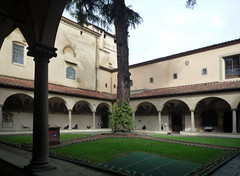
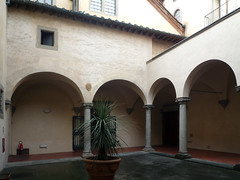

Paolo Uccello, Battle of San Romano
by DR. BETH HARRIS and DR. STEVEN ZUCKER
Video \(\PageIndex{14}\): Paolo Uccello, Battle of San Romano, probably c. 1438-40, (National Gallery, London)
Fra Filippo Lippi
Domenico Veneziano, Saint Lucy Altarpiece
by DR. STEVEN ZUCKER and DR. BETH HARRIS
Video \(\PageIndex{15}\): Domenico Veneziano, Saint Lucy Altarpiece, 1445-47, tempera on wood panel, 82 1/4 x 85″ or 209 x 216 cm (Galleria degli Uffizi, Florence)
Additional resources
This painting at the Uffizi
Smarthistory images for teaching and learning:

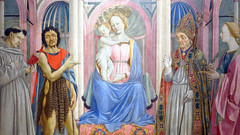
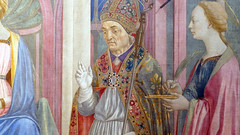
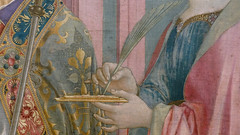
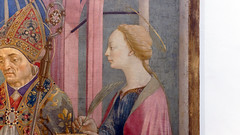
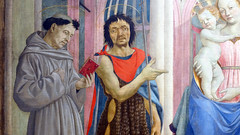

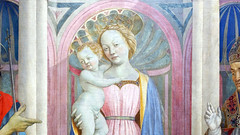
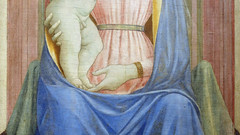
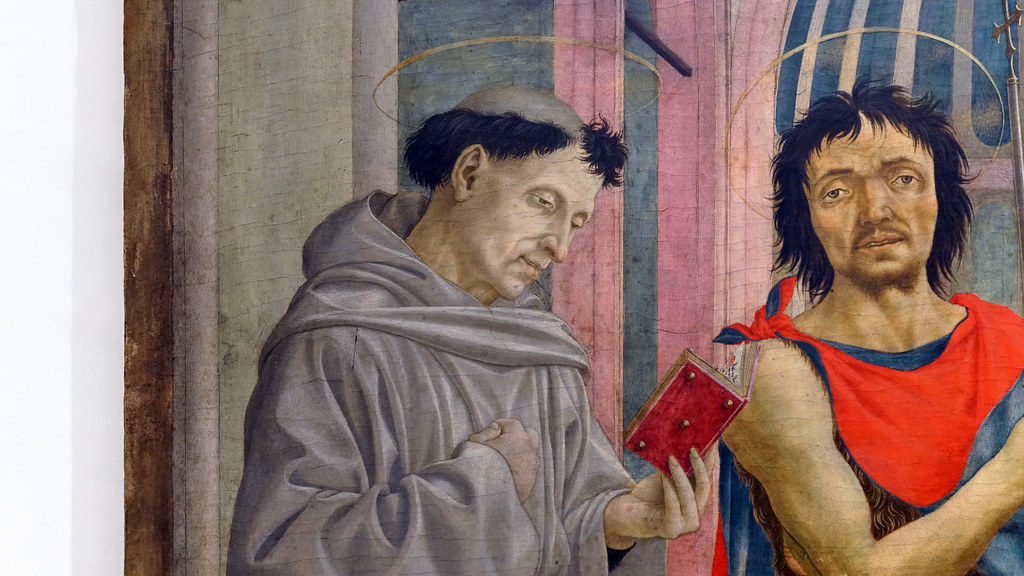
Antonio Pollaiuolo, Battle of Ten Nudes or (Battle of Nude Men)

Antonio Pollaiuolo’s Battle of Ten Nudes has been called the single most important engraving in European history. Clearly based on classical antiquity (the cultures of ancient Greece and Rome), the print is monumental in size (approximately 15 x 23 inches) and, because of its shallow space, resembles ancient Roman relief sculpture. In the picture, five men wearing headbands fight against an equal number of men without headbands. The battle is set in front of a wall of lush vegetation.

Art historians disagree about whether the print depicts a particular scene from mythology or classical history, but some have suggested that it simply shows gladiators. This is because in the central pair, the men are gripping a chain, a common weapon of gladiatorial combat.

The print is exceptional for many reasons. To begin with, over fifty copies of it exist, an extraordinarily high number for a work of art over 500 years old. Additionally, it is believed that Pollaiuolo engraved the print completely by his own hand, and for this reason, the sign set in the far left of the vegetation bears his name (most often the artist’s composition would be engraved by a printmaker).
Pollaiuolo’s print is, however, important mostly because it shows a new conception of the human body. As many art historians have noted, the Renaissance started much earlier in the fields of sculpture and architecture than it did in painting and drawing. So although Donatello had created his nude David decades earlier, the nude had yet to be mastered in a two-dimensional form. Not everyone was taken with Pollaiuolo’s print, and it is believed that Leonardo da Vinci criticized it, saying that the bodies looked like “bags of nuts.” Pollaiuolo’s nudes may be overly muscular, but they were probably the most naturalistic human bodies created in Italy up to that point.

Vasari, the great sixteenth-century Florentine artist and art historian, wrote that Pollaiuolo’s understanding of the nude body resulted from his dissection of cadavers. This became a common practice in Florence, and it is reported that a sculpture of the crucified Christ in Santo Spirito was a gift from a very young Michelangelo to the priest there, who basically let him rob graves for the purpose of dissection.
Pollaiuolo’s bodies are also derivative of ancient Roman art, an indication that he was looking at the classical past for inspiration, an essential hallmark of the Renaissance.
Because Pollaiuolo was trained as a goldsmith (this was true of many artists of the Renaissance including Ghiberti and Brunelleschi), he was very skilled in working with metal. Apart from its conception of the nude, the print also showcases the artist’s technical ability, especially in the modeling, or contouring of light and dark, used to create volume in the men’s bodies.

Although to the modern viewer, the fight between the ten men may look stiff and posed (although, a particularly vivacious passage can be found in the bottom left hand corner, where the man on the ground fiercely strains against the man pressing his head into the ground), later works by Michelangelo and Leonardo owe much to it. It is impossible to think that either Michelangelo’s Battle of the Centaurs (below) and Battle of Cascina or Leonardo’s Battle of Anghiari could have existed without the prototype of Pollaiuolo’s Battle of Ten Nudes.

This print is an engraving. That means that with a sharp tool, Pollaiuolo scratched the drawing into a sheet of metal. Ink was then applied to the metal surface and subsequently wiped off, leaving only the incised lines filled in. A piece of moist paper was then set over the plate, which was sent through rollers so that the wet paper could “suck up” the ink. At the end, the sheet of paper was peeled off, and the image that resulted was the mirror image of what Pollaiuolo drew.
In fact, art historians have identified that two stages of the print actually exist. This means that at some point, the metal plate wore down, and the artist had to recarve some of the details back into the plate. The result is that, over time, two different images were pulled from Pollaiuolo’s one plate.
Because prints were collected like modern day baseball cards, engravings of The Battle of Ten Nudes ended up all over Europe, and many other artists copied it. Although people in other parts of Europe might read about the great sculptures and buildings being constructed in Florence, Pollaiuolo’s print was an actual piece of the Florentine Renaissance that they could hold in their hands. Prints like this did much in helping to spread the Renaissance throughout Italy and to the rest of the world.
Additional resources:
This print at the British Museum
Smarthistory images for teaching and learning:
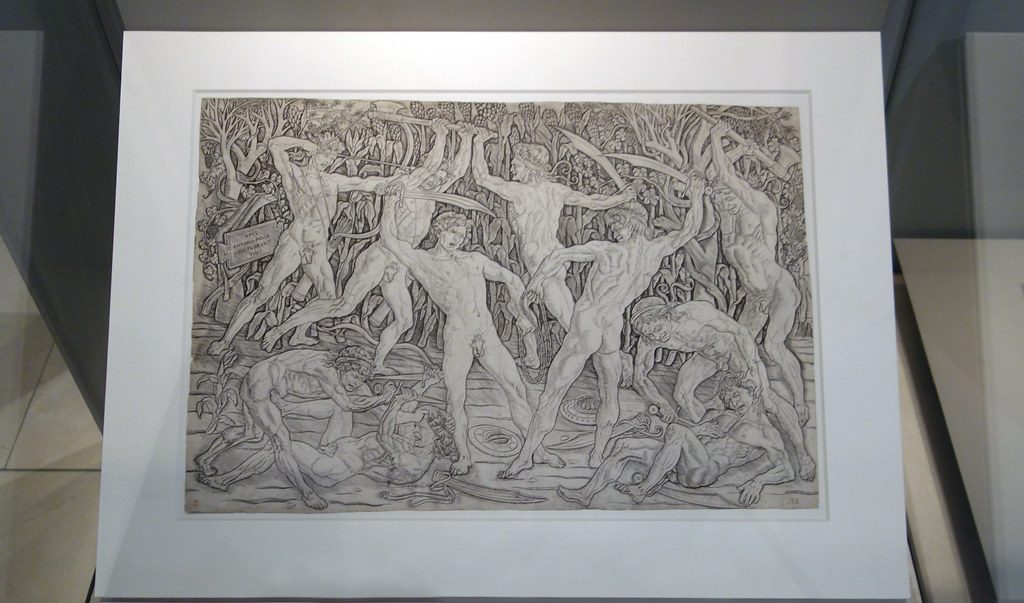
Perugino, Christ Giving the Keys of the Kingdom to St. Peter
by DR. SHANNON PRITCHARD

St. Peter—keeper of the keys
Pietro Perugino’s Christ Giving the Keys of the Kingdom to St. Peter is an exemplar of Italian Renaissance painting. The work was part of a large decorative program commissioned by Pope Sixtus IV in 1481 for the walls of the Sistine Chapel (the name “Sistine” being derived from Sixtus’ own name), which was then, as it is today, the pope’s private chapel in the Vatican, in Rome. This large scale fresco, measuring 10’10” x 18’, is part of the New Testament narrative cycle depicting events from the life of Christ on the north wall of the chapel (the south wall illustrates the Old Testament life of Moses).

The painting shows the moment when Christ, standing in the center dressed purple and blue garments, gives the keys of the heavenly kingdom to the kneeling St. Peter. This episode comes from the Gospel of Matthew (16:18-19) as Christ said to Peter: “And I tell you that you are Peter (Petros), and on this rock (petra) I will build my church… I will give you the keys to the kingdom of heaven….” The pair of gold and silver keys became Saint Peter’s attribute (an attribute, in this sense, is an object associated with a saint that aids the viewer in identifying the saint). More about Peter
The Renaissance ideal
Perugino pulled out every pictorial device in his painter’s arsenal to construct an image that is reflective of Renaissance ideals: figures, balance, harmony, and three-dimensional space. To begin with, see that the pictorial field has been clearly delineated into three distinct planes: foreground, middle-ground and background. In the foreground, on either side of Christ and St. Peter—are the other eleven Apostles. Who are the Apostles?
You can identify them easily since they are the figures dressed in classicizing tunics and robes. Each has been carefully rendered as a distinct individual. Perugino harmonizes the figures through repeating colors and postures. Notice how blue, yellow, and green are repeated throughout the group in a way that draws the viewer’s eye back and forth across the foreground.
Let’s also look at the postures of our Apostles. At the left and right edge of the Apostolic group is a figure with his back to the viewer, looking toward the central action. This effectively draws our eye to the center as well. The next figure over on both sides, faces out towards us, and their poses are mirror reflections of one another. Perugino’s harmoniously balanced grouping of historical figures provides visual interest for the viewer.
However, there is one element that is incongruous with the rest, which is the addition of contemporary Roman and Florentine men at the far edges of the groups on either side of Peter and Christ. These figures are clearly not part of the biblical figures based on their dress— and there is even a portrait of the artist himself, who looks directly out to the viewer on the right hand side (the fifth figure from the right edge—see the image above) ! The inclusion of the artist and / or contemporary people associated with the project was common during the Italian Renaissance, and in this case, Perugino’s presence acts as his visual signature to his work.

In the middle-ground, the figures are much smaller than those in the foreground, suggestive of their spatial distance. Not merely passersby, these figures are part of two additional stories from the life of Christ. On the left is the Tribute Money from the Gospel of Matthew (17:24-27) where the Roman tax collector demands Christ pay the Emperor’s tax. (This scene was famously represented by Masaccio in the Brancacci Chapel in Florence). On the right is the Stoning of Christ from the Gospel of John (8:48-59). The addition of these two scenes creates a pictorial device known as a continuous narrative, where two or more related events are shown occurring simultaneously in one composition.
The background is comprised of three architectural structures at the edge of the open piazza (plaza), with an ideal landscape extending far into the distance behind. In order to create such a believable sense of three-dimensional space, Perugino utilized two types of perspective.

The first, one-point linear perspective, creates a believable three-dimensional space using a system of orthogonals (diagonal lines seen on the pavement—in red in the diagram above) that recede into space, converging at one point known as the “vanishing point” (which in this case is in the doorway of the central building).”
The vanishing point is located along a horizontal line, the “horizon line,” which establishes the boundary between land and sky (the blue line in the diagram above). Notice how all of the figures maintain a proportional relationship to each other as they recede into this space.
The second type of perspective Perugino used is atmospheric perspective, which is literally the effect of the atmosphere on objects observed in the distance, causing them to diminish in appearance through a bluish-gray haze, as seen in the mountains in this case.
The influence of classical antiquity

Contrapposto
One of the defining characteristics of the Italian Renaissance was the interest in all aspects of classical antiquity (ancient Greece and Rome), especially its art and architecture. That interest in manifested in Perugino’s fresco in two different ways. One is his use of contrapposto (Italian meaning “counter-pose”) for some of the foreground figures.
This pose (seen in the figure above) was known in the Renaissance through copies of the ancient Greek sculpture, the Doryphoros (above right). When standing in contrapposto, one leg bears all of the person’s weight while remains relaxed at the knee, producing a very natural stance (notice how often you stand in contrapposto every day!).

Architecture
The second nod to antiquity is in the architecture. The central “temple” in the background of Perugino’s fresco is based on the Florence Baptistery, which was believed at the time to have been an ancient Roman temple.
And at either side of the piazza are representations of the Arch of Constantine (in Rome). The arch commemorates Constantine the Great, the Roman emperor who legalized Christianity in 314. Famously converting to Christianity on his deathbed in 336, he effectively became the first Christian Roman emperor. Moreover, Constantine founded St. Peter’s Basilica, the site of Peter’s burial and the location of Perugino’s fresco. Thus, the inclusion of the Arch of Constantine was an important reference to the history of Rome, and St. Peter and the basilica.
Ghirlandaio, Life of the Virgin
by DR. SALLY HICKSON
A treasure house of Renaissance art
The Church of Santa Maria Novella, adjacent to the train station of the same name, is a treasure-house of Florentine art of the Renaissance.

So much so, that visitors to the church—seeking the great Renaissance artists Uccello and Masaccio and the wondrous frescoes in the “Spanish Chapel”—are sometimes prone to overlook the magnificence of its main altar chapel (or chancel), painted by the absolute master of Florentine fresco, Domenico Ghirlandaio and his workshop. Known as the Tornabuoni chapel (for the family that commissioned the paintings), the frescoes were once the culmination of the pilgrim’s journey down the central nave and through a large wooden choir (an area for seating for the clergy and choir), which funneled the traveler through the final third of the journey to deliver them at the doorstep of Ghirlandaio’s glorious vision (the painter and author Vasari tore the choir down in the sixteenth century—as it turns out, he wasn’t much one for preserving material culture).

A banker’s commission

At the time of this commission, the Tornabuoni were the chief Florentine banking rivals of the Medici. Like the Medici, they employed this kind of sacred patronage to expiate themselves against charges of immoral luxuriousness and wealth, as well as to quell suspicions of usury (charging interest, which was considered a sin). The irony, of course, is that a fresco insurance policy as grand as this one was only obtained at great cost, and was intended to attract maximum public attention. The extravagant “humility” of rich patrons (the Medici, the Tornabuoni and others), adorning the city with thinly-veiled monuments to themselves, came to be considered a demonstration of virtuous public service, celebrated as civic magnificenza. I suppose Donald Drumpf may see himself in the much the same way, scattering his showy, shiny monuments across America.
The Bible in Florence
Ghirlandaio loved Florence and fresco, and he adored the world and all of its charms. In contrast to the solid, stoic and severe formal classicism of the earlier generation of Alberti, Brunelleschi and Masaccio, Ghirlandaio loved form, color, variety, narrative and the quotidian (everyday) details of Florentine daily life. Although the primary narratives depicted in the Tornabuoni Chapel are scenes from the Life of John the Baptist and from the Life of the Virgin, these biblical scenes unfold in the streets of Florence, often staged in what appear to be temporary stage-sets, theatrical triumphal arches and temples, strewn with various bits of ancient Roman bric-a-brac, hastily assembled for the biblical actors. When you peer through the arches of these Lego-land wonders, you see the solid, sturdy, stone medieval façades of Florence—no matter where he goes in his imagination, for Ghirlandaio, Florence is the whole world. The conflation of time past and time present in the frescoes is also underscored by the inclusion, in many scenes, of late-fifteenth-century members of the Tornabuoni family in the biblical subjects, floating across the stage like ghostly apparitions. For over 500 years these vivid frescoes have played across the walls of the chapel like a continuously looping documentary film, chronicling the living history of Florence.
The painter
Domenico Ghirlandaio is often given rather short shrift by art historians existing, as he did, suspended between the austere Albertian mathematical rationalism of the fifteenth century and the agonized, self-flagellant extravagances of Michelangelo, to whom he served as painting master before he took up residence in the Medici garden. Trained in the family workshop, Ghirlandaio was an acknowledged fresco expert, and while his style is sometimes dismissed as “prosaic,” I find it happily idiomatic, clearly reveling in the quotidian joys of observing the world around him—which is not to say that he lacked imagination. He had a distinct penchant for embellishing severe classical architectural settings with fanciful, fluid and flirtatious decorative flourishes and then peopling them with the most extraordinarily vivid and lively figures.
Every picture tells a story: The narratives
The overall narrative program of the chapel is relatively simple, covering the two lateral walls, and part of the rear wall (around and above the magnificent stained-glass windows) in superimposed registers, culminating in frescoes of the Four Evangelists on the ceiling.

Facing into the chapel, the frescoes to the viewer’s left tell the story of the life of the Virgin, to whom the church is dedicated, and those on the right, the story of the Life of St. John the Baptist, the patron saint of Florence. Both of these narratives feature birth scenes; the birth of John the Baptist, the Birth of the Virgin, the Nativity of Christ. The message is clear—three mothers, two sons, two dispensations. John’s fate, as the last Prophet of the Old Testament and first Apostle of the New Testament, is to recognize Jesus as the Messiah—this translation from old to new is the lynchpin that holds the cycles together.

The fact that some of these biblical births are attended by prominent and highly recognizable female members of the Tornabuoni family reveals at least two subtexts behind this natal cycle—in the first instance, it’s about dynasty, continuity, and the perpetuation of the Tornabuoni family. But there is a sad and ironic touch to this dynastic documentary; in the birth scenes of St. John and of the Virgin, a cortege of court ladies is led into the scene by the wife of Lorenzo Tornabuoni, the solemnly beautiful Giovanna who sadly died In childbirth while Ghirlandaio was painting this cycle (a lovely portrait of Giovanna by Ghirlandaio, left). The frescoes are, therefore, touching commemorative tributes to Giovanna, mingling the joys of birth with the sadness of death and the hope for eternal salvation.
The life of the Virgin
Among the many lovely aspects of the life of the Virgin, the loveliest is the story of her conception, born of a kiss between the aged Joachim and the long-barren Saint Ann, as they linger by the city gate. Ghirlandaio places this close encounter of the biblical kind at the top of a staircase inside what appears to be a contemporary Florentine palace, where it gives way seamlessly to the contiguous Birth of the Virgin, easily the best-known scene from the chapel.

St. Anne props herself up in her fifteenth-century platform bed, in a luxuriously paneled room topped by a continuous frieze of illusionistically “carved” chubby, churning dancing putti. Midwives in the foreground pour water from an elegant pewter jug into a pewter basin, preparing baby’s bath. The baby is a wriggling delight, held by a midwife and facing toward the still-floating Giovanna Tornabuoni, accompanied by her usual female entourage, all sumptuously dressed in high fifteenth-century Florentine style. Their presence is a reminder of the customary visits made by women of aristocratic families on the occasion of a birth.

We next proceed through the Presentation of the Virgin, fluttering up the stairs to the high priest, her marriage to Joseph, the Nativity and, on a different note, the Massacre of the Innocents (image below—showing the execution of all young male children in the vicinity of Bethlehem ordered by King Herod to avoid the loss of his throne to a newborn King of the Jews whose birth had been announced to him by the Magi). But even here, in a scene of violent infanticide, Ghirlandaio can’t shed his delight in fluttering, colorful sinuous draperies and an over-abundance of happy detail, which tends to highlight the ghoulishness of the dismembered baby parts strewn across the foreground, as though the putti of the Virgin’s chamber (see the Birth of the Virgin above) had crumbled from the walls.

The life of Saint John the Baptist
There are a number of frescoes depicting standard scenes associated with the life of the Baptist—chiefly his wanderings in the desert, during which he realizes his avocation, and his subsequent Baptism of Christ. But people sometimes forget that John, like Christ, was the result of a miraculous pregnancy. His parents, Zachariah and Elizabeth, had no children, but God heard Zachariah’s prayers and the elderly Elizabeth found herself pregnant, three months in advance of the Annunciation to the Virgin Mary (the moment when Mary conceives Christ). The cycle therefore features the lovely moment of the Visitation, when Elizabeth and Mary encounter each other while pregnant and the unborn John “leaps up” in his mother’s womb in recognition of the presence of Christ (Luke 1: 39-45).

In his typical fashion, Ghirlandaio sets this encounter in a hybrid city setting; the women stand just inside a medieval wall and the Virgin faces toward the gliding and omniscient presence of Giovanna Tornabuoni.

On the far right is the profile of a gleefully festooned triumphal arch. In this confrontation of architectural styles, medieval and Renaissance, the old medieval world gives way to the newly reborn “Roman” present, a trope Ghirlandaio borrowed from contemporary Netherlandish art. St. John the Baptist has his own lovingly detailed birth scene, complete with a rushing female figure carrying a birth tray of fresh fruits and replenishing foods to the new mother, the ever-watchful Giovanna Tornabuoni in the foreground.

Among the other scenes here, the one in which Zaccariah Writes the Name of John is the most unusual. At the moment of the angel Gabriel’s announcement of Elizabeth’s pregnancy, Zaccariah asked for a sign as proof; because he had spoken doubtfully, he lost the power of speech, regaining it only after writing on a tablet, at Elizabeth’s urging, “His name is John” (Luke 1:18-22). The emphasis in this scene on written evidence is, perhaps, an allusion to the world of documents and contracts that characterized the Tornabuoni banking world.
The altar wall

On the lowest register, the altar wall features kneeling portraits of the donors, Giovanni Tornabuoni and his wife Francesca Pitti. In the upper registers, around and above the triple-mullioned stained-glass windows, we see the Annunciation and St. John in the Desert, then scenes from the lives of two prominent Dominican saints, appropriate in a Dominican church. In one, Saint Dominic Tests Books in Fire and in the other we see the Death of Saint Peter Martyr. The cycle on this wall culminates in a Coronation of the Virgin with Saints.
Again, for Ghirlandaio, God is clearly always in the details. The Saint Dominic scene depicts a moment in the saint’s fight against the Cathars (who professed a belief in the dualistic principles of good and evil, God and Satan, in opposition to the monotheism of the Catholic faith), in which only his books survived a test of fire when thrown into the flames alongside the Cathar’s “heretical” texts.

This is interesting because of its juxtaposition with the Death of Peter Martyr; a preacher from Verona whose family was sympathetic to the Cathar cause. He returned to orthodoxy when he met Saint Dominic. As Shakespeare says, “the truth will out.” I have no idea why late-fifteenth-century Dominicans were concerned with the Cathars, but it’s possible that the reference to Catharism here was intended by the Tornabuoni to “out” rival merchant families in Florence, like the Pulci, whose ancestors were associated with the Cathars. Thus the personal is intertwined with the political, all interwoven into the marvelous textures of Ghirlandaio’s Florence.
Cassone with the Conquest of Trebizond
by ELAINE HOYSTED

All the items a bride would need
As one of the few cassoni (marriage chests) to survive intact from the fifteenth century, The Metropolitan Museum of Art’s Cassone with the Conquest of Trebizond provides us with the opportunity to understand Renaissance Florentine social and political ideals and attitudes. Cassoni (also called forzieri in Florence) were expensive, lavishly decorated chests which accompanied a bride to her new marital home. These chests were given to the bride by her parents as their contribution to the wedding. Carrying precious textiles and goods such as expensive clothing, jewelry and accessories, the chests contained many of the items the bride would need and use in her new home. The cassone was carried alongside the bride accompanied by her father and family through the streets of Florence, an important part of the ritual of marriage. It served to demonstrate the wealth of the family to the city’s citizens, displaying their power and influence.

Each of the main surfaces of the chest were decorated, often with painted horizontal panels depicting narratives (istorie) taken from such sources as Greek and Roman mythology, the Old Testament and fourteenth-century literature (for example the work of Boccaccio and Petrarch were particularly popular). The Metropolitan’s Cassone stands out due to the choice of subject matter on the front panel (above)—depicted a contemporary historical event, the Conquest of Trebizond (in present-day Turkey) as well as for the two artists involved—Marco del Buono Giamberti and Apollonio di Giovanni di Tomaso.
Emblazoned on each of the side panels of the chest (left) is the family emblem (imprese) of the Strozzi, an ancient and noble Florentine family with strong political influence. The emblem, comprised of a falcon/hawk perched on a caltrop (a spiked metal device that when scattered on the ground in battle, caused the enemy’s horses to trip and fall), would have been immediately identifiable to those on the streets of Florence. This symbol therefore served to identify the family involved and the conspicuous expenditure of the Strozzi, reinforced by their numerous artistic and architectural projects in the city such as Gentile da Fabriano’s Adoration of the Magi.

The inside of the cassone provides insight into the role of women in Florentine society and the expectation that they bear children. Often the inner lid of cassoni were decorated with the representation of an erotic and sensuously nude reclining male or female figure. It was believed at this time that in order to conceive a beautiful (preferably male) child, women should surround themselves with beautiful and stimulating art works. In the case of the Metropolitan Cassone, the inside of the lid and the back panel (above) are decorated with painted imitations of textile designs—pomegranate-style velvets with metal-thread brocading and two heights of silk pile. The extravagance of the decoration mirrors the expensive nature of the objects which it housed. Of particular interest is the pomegranate motif and its relationship to the bride’s role as a wife and mother. In Renaissance society pomegranates were recognized as symbols of fertility. Each time the newly-married woman opened up the cassone, she saw this symbol, reminding her of her prescribed role in marriage.

The back view of the cassone appears to be unfinished. The reason for this becomes apparent when the location of the piece is taken into consideration. The chest was placed in the private bedchambers of the wife—usually at the foot of the bed. As it was placed in this manner, the back panel was not on display and therefore the finish was not seen as a priority by the workshop, certainly not to the same extent as the rest of the piece. This demonstrates that both the patron and artists attempted to reduce the cost of the work where possible, preferring to concentrate the lavish decoration and finish to the areas which would be visible to the public when carried through the city and to the eyes of the couple when installed in their home.

The front panel of the cassone was originally thought to present a contemporary historical event—the fall of the city of Trebizond (modern-day Trabzon in Turkey) at the hands of the Ottoman Sultan Mehmed II in 1461. Located on the southern coast of the Black Sea, Trebizond was considered at the time as the last outpost of the Byzantine Empire and its surrender signaled the end of that Empire. The victory of the Ottoman Turks (Muslims) signified the serious threat they now posed to Europe. Therefore this event was of particular relevance to contemporary Florentines, especially those from the elite class such as the Strozzi.

In the top left corner of the painted panel, the walled city of Constantinople is represented (above). In the top right (below), dominating a hill is the city of Trebizond. In the middle and foreground, a battle scene is portrayed. Opulently-dressed soldiers whose costumes are decorated in the expensive medium of gold leaf fight on foot and on horseback.

Outside Trebizond’s walls, the Ottoman encampment and the copious amount of gold leaf utilized to depict it, stands out from the rest of the scene. Mehmed II is seated on a triumphal chariot pulled by two white horses in the bottom right, demonstrating his importance in the scene as the victorious leader. The abundant use of gold leaf shows the patron’s wealth and recalls the similar treatment of the theme of opulence as seen in Da Fabriano’s Strozzi Altarpiece.
New interpretation

Recent analysis of the cassone and particularly the costumes of those depicted in this panel revealed that it is in fact the Ottoman forces who are being vanquished. It is now believed that the artists deliberately conflated two historical events within the one scene: the fall of Trebizond in 1461 and a battle which took place in 1402, when the Ottomans were defeated at the hands of the famous Mongol Emperor Bayezid I and his troops at Ankara. By conflating these two events in this manner, the artists visualized the idea that the Ottomans were not invincible and although they had brought about the fall of the Byzantine Empire, they could be defeated once again. The panel therefore reinforced the belief that the Ottomans were no match for the might of the armies of mainland Europe.
Although an object destined for the private bedchambers of a newly-married couple, the Cassone with the Conquest of Trebizond brings together successfully the prescribed domestic duties and political concerns of fifteenth-century Florentines.
The Cassone at the Metropolitan Museum of Art
Cassone at the Minneapolis Institute of Art
The conservation of a Renaissance Cassone at the Victoria and Albert Museum
Smarthistory images for teaching and learning:


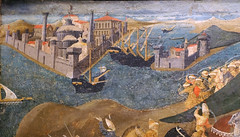

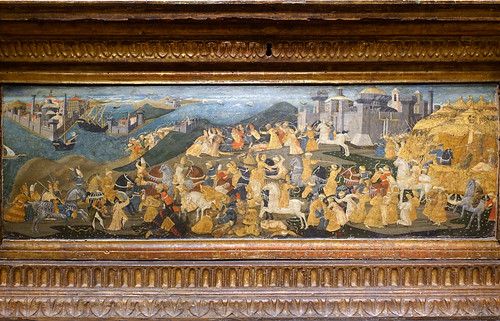
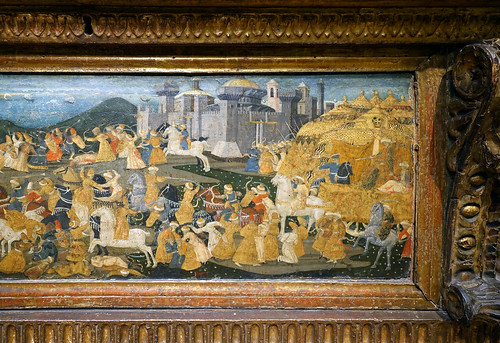
Sandro Botticelli
Sandro Botticelli, La Primavera (Spring)
by DR. BETH HARRIS and DR. STEVEN ZUCKER
Video \(\PageIndex{16}\): Sandro Botticelli, La Primavera (Spring), 1481-82, tempera on panel, 80 x 123 1/2″ (203 x 314), (Uffizi, Florence)
Sandro Botticelli, The Birth of Venus
by DR. BETH HARRIS and DR. STEVEN ZUCKER
Video \(\PageIndex{17}\): Sandro Botticelli, The Birth of Venus, 1483-85, tempera on panel, 68 x 109 5/8″ (172.5 x 278.5 cm) (Galeria degli Uffizi, Florence)
Additional resources:
Botticelli, Portrait of a Man with a Medal of Cosimo il Vecchio de’ Medici
When browsing a museum, I’m sure we’ve all experienced the strong desire to touch a work of art (we know we shouldn’t, but I think we can admit we’ve all wanted to). Well, Sandro Botticelli’s Portrait of a Man with a Medal of Cosimo il Vecchio de’ Medici was made to incite touch, or at least to make viewers think about touch and physical experience.
Seeing Botticelli’s Portrait of a Man reproduced online, in the pages of a book, or even when walking past it in Florence’s Galleria degli Uffizi, where it is protected by a layer of glass, modern viewers may miss a key aspect of the painting. However, the typical fifteenth-century viewer of this portrait likely would have been able to touch the object itself, and at the very least could easily draw from memory the experience of handling an object much like the medallion held by the portrait sitter, as portrait medallions were frequently dispersed and collected among the upper classes.
Upon closer inspection, you’ll notice that this isn’t a two-dimensional portrait painting, but a multimedia work. The sitter is indeed painted quite naturalistically, so he looks three-dimensional, as though he could potentially exist in our world. The medallion that he holds, however, actually is three-dimensional. This portrait, like many paintings in fifteenth-century Italy, is painted with tempera on a wood panel. In this case, a hole has been cut in the panel, where the sitter appears to be holding the medallion, and a copy of a real portrait medallion has been inserted into that space.
This pseudo-medallion is not actually made of metal, as a true medallion is, but it is instead built of pastiglia, a paste or plaster, made with gesso and built in low relief. In this portrait, the pastiglia medallion has also been gilded, or covered in a thin layer of gold leaf, to mimic the appearance of a gilded bronze medallion. Because the image and text on this pseudo-medallion exactly mimic the orientation of Cosimo’s portrait on real medallions from this period, it is possible that Botticelli used the impression of an existing medallion to make a mold, or had access to a mold used to create such medallions.
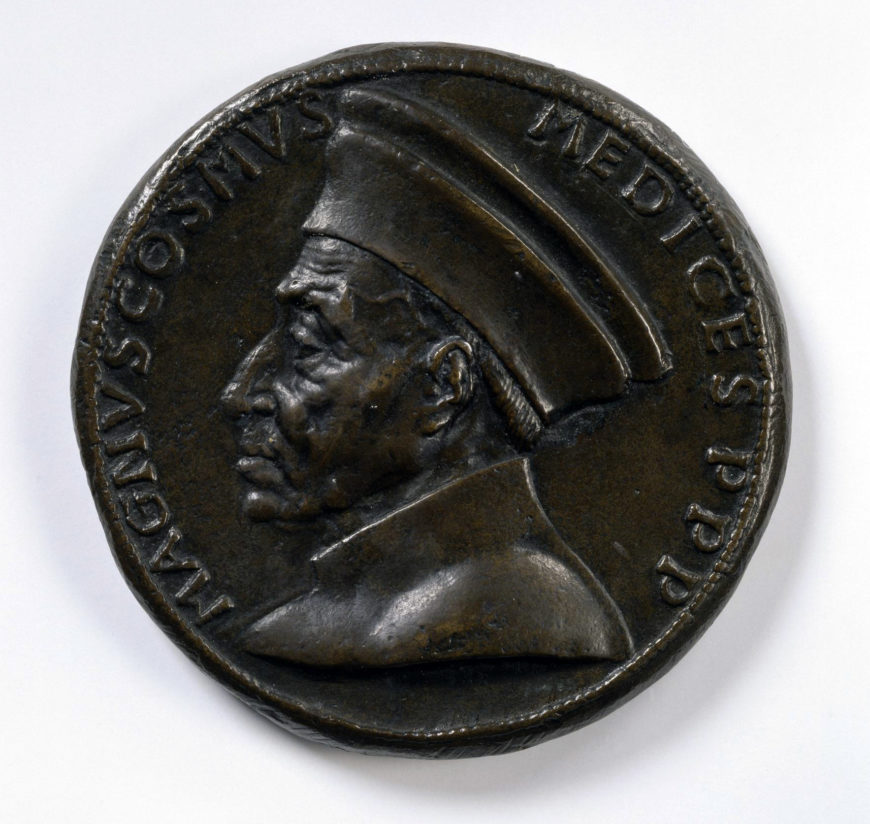
Who is this man?
Well, we don’t know, despite much scholarly speculation over the years. We can discern that he is certainly intending to associate himself with one of the most powerful families in Italy at this time, the Medici. He does so by holding a large copy of a real, existing portrait medallion—an object that would have been made in multiples, circulated, traded, and collected by humanists and upper-class members of Renaissance society.
The young man in Botticelli’s portrait looks directly out at the viewer and appears proud of his connection to the object that he holds. He displays the large medallion right over his heart, an organ that was associated with the creation of lasting memories and the storage of sense impressions. The sitter is dressed as a humanist, a learned member of Florentine society.
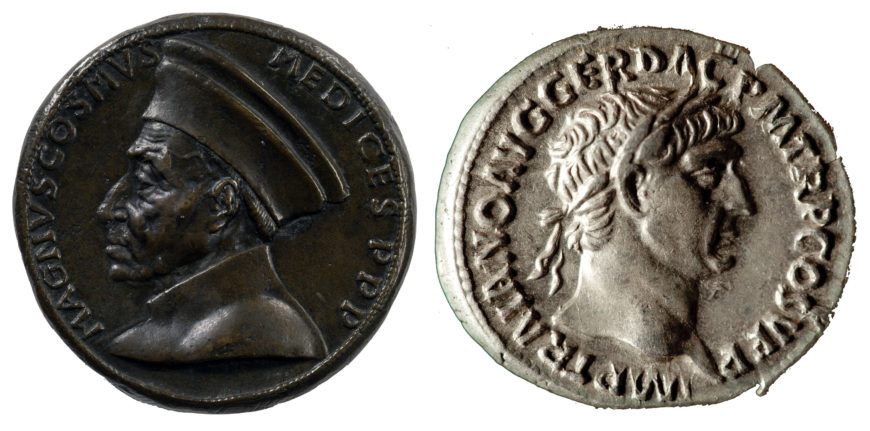
The medallion, as a copy of a real object, shows the profile view of Cosimo il Vecchio (the Elder), with Latin text arching above his portrait. The text makes reference to Cosimo il Vecchio as pater patriae, or “Father of the Fatherland.” This phrase indicated the political power of the Medici, which began during Cosimo’s lifetime. The format of the pseudo-medallion is drawn from coins and medals of Greek and Roman antiquity, thereby effectively associating Cosimo with great rulers of a learned past, a past that Renaissance humanists hoped to emulate.
Who were the Medici?
Why would someone in Renaissance Italy want to be associated with the Medici family? And why Cosimo il Vecchio, in particular? The Medici were the most powerful family in Florence, and remained one of the most influential families in Italy—and Western Europe more broadly—throughout the Renaissance. Even though Cosimo il Vecchio was deceased by the time of this portrait, he was remembered as the de-facto “father” of the wealthy banking, mercantile, and political family. Beginning with Cosimo and his political rule, the Medici helped to make Florence the cradle and birthplace of the Italian Renaissance, as they were responsible for financially supporting many advances in the arts and humanities. By 1475, when this portrait was painted, the grandsons of Cosimo, Lorenzo and Giuliano, were co-rulers of Florence. Just a few years later, in 1478, Giuliano was killed in the Florentine Cathedral of Santa Maria del Fiore (the Duomo) during the assassination plot known as the Pazzi Conspiracy. At this time, Lorenzo il Magnifico (the Magnificent) de’ Medici became head of the family and the Medici rule in Florence.
Lorenzo, in particular, surrounded himself and filled his court with artists, architects, writers, and other humanist scholars. Sandro Botticelli was one of these, looked upon quite favorably by Lorenzo and given numerous commissions during his time as a court painter for the Medici. This portrait was thus created during one of the great heights of Medici Renaissance power and influence. In just a few decades, in fact, two members of the family would become popes—Pope Leo X (Giovanni di Lorenzo de’ Medici) and Pope Clement VII (Giulio di Giuliano de’ Medici). In short, if one had the ability to claim even a tangential connection to the Medici family, it would only make sense to document that connection for eternity in a work of art, such as our Man with a Medal.
Botticelli, the Medici, and Renaissance portraiture
And, again, Botticelli was able to claim just such a connection himself. In fact, the artist famously includes his self-portrait in an image of the Adoration of the Magi, also painted around 1475. The Medici were known to frequently associate themselves with the three kings as a way of showing their loyalty to the Christian faith and their will to also gift expensive things to Christ (carried out in the Renaissance by way of commissioning religious works of art and architecture). As such, many recognizable portraits of Medici family members can be found in the Adoration of the Magi. Botticelli perpetually commemorates his connection to this powerful family by adding his own portrait to the group.
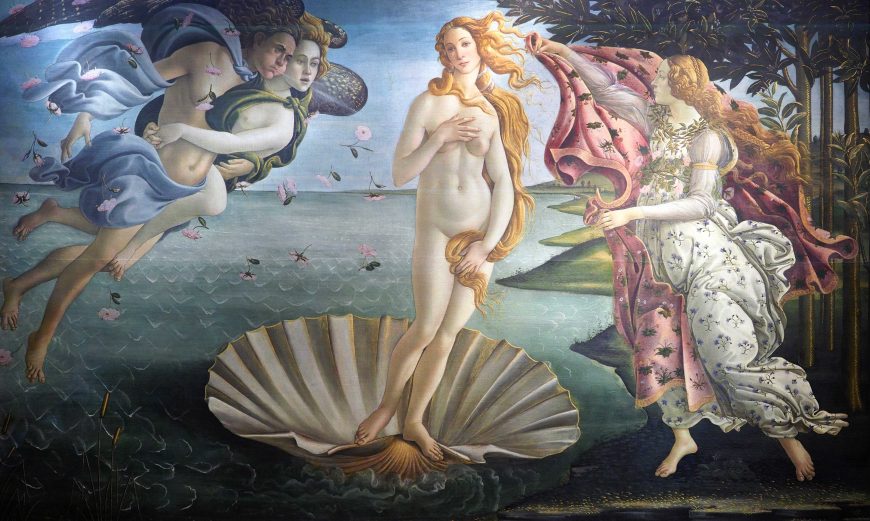
The best-known works by Botticelli are religious and mythological scenes, such as his Birth of Venus, which can also be found in the Uffizi Gallery. However, Botticelli was also widely celebrated for his technical abilities in the genre of portraiture. In the last quarter of the fifteenth century, artists were continually working towards creating ever more communicative and naturalistic portraits.
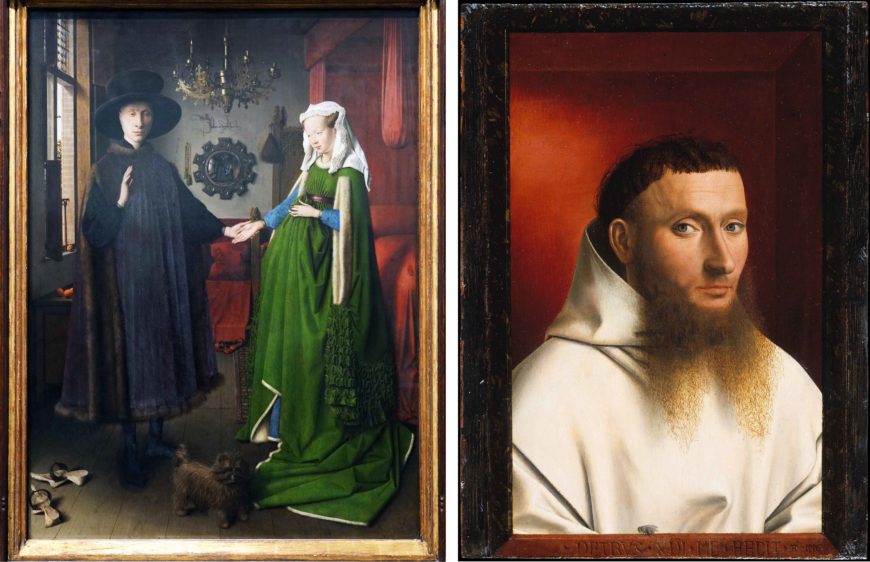
Moving away from the classically-inspired strict profile format and turning to a three-quarter twist of the body inspired by Flemish portraiture, artists like Botticelli, Leonardo da Vinci, and Antonello da Messina were revolutionizing the entire genre of portraiture.
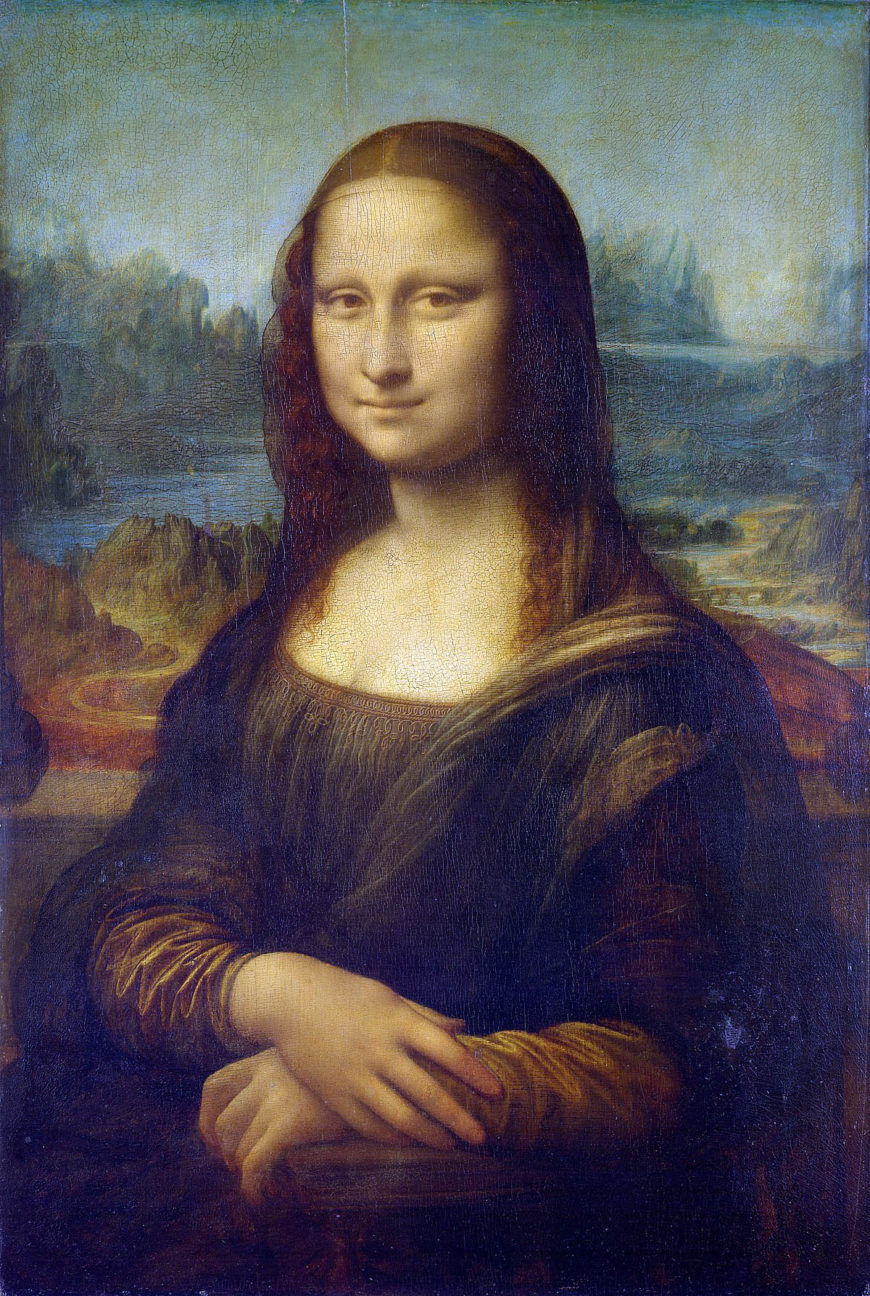
Painters from regions north of the Alps created portrait likenesses that turned toward their viewers and appeared to make eye contact, ultimately inspiring Italian artists, already heavily invested in naturalism, to do the same. In addition, Leonardo da Vinci’s portraits, as well as many of Botticelli’s, also began to incorporate more of the body (consider, for example, how a viewer sees the entire turn of the Mona Lisa‘s upper body, even the placement of her hands), thereby adding an even greater sense of physical presence to the sitters.
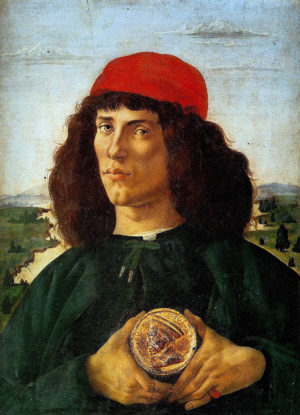
A truly unique portrait
Botticelli’s Portrait of a Man with a Medal of Cosimo il Vecchio de’ Medici is particularly special because it incorporates the “old” format of portraits in its medallion—those in strict profile, meant to reference similar objects from antiquity—along with the newly popularized approach that captured more lively and communicative sitters, sitters that make eye contact with their viewers. Here, Botticelli’s young man looks directly out at us, capturing our attention and thereby directing it to what he holds. We feel as though he is speaking to us, asking us to touch this three-dimensional medallion and to remember his status, amplified by his ties to this important family. The artwork combines old and new, painting and sculpture, to create one of the most unique and enthralling portraits of its time.
Additional Resources:
This portrait on the Gallerie degli Uffizi website
Read more about the presentation of self in the Italian renaissance via Italian renaissance learning resources
Why commission artwork during the renaissance?
Types of renaissance patronage
View another Italian renaissance artwork that uses pastiglia on Smarthistory
Read more about the Medici as collectors
Francis Ames-Lewis, ed., The Early Medici and Their Artists (London: Birbeck College, 1995).
Allison M. Brown, “The Humanist Portrait of Cosimo de Medici, Pater Patriae,” Journal of the Warburg and the Courtauld Institutes, vol. 24, no. 3/4 (1961), pp. 186–221.
Rebecca M. Howard, “A Mnemonic Reading of Botticelli’s Portrait of a Man with a Medal,” Source: Notes in the History of Art, vol. 38, no. 4 (2019), pp. 196–205.
Richard Stapleford, “Botticelli’s Portrait of a Young Man Holding a Trecento Medallion,” Burlington Magazine, vol. 129, no. 1012 (1987), pp. 428–436.
Portraits and fashion: Sandro Botticelli, Portrait of a Young Woman
by DR. LANE EAGLES
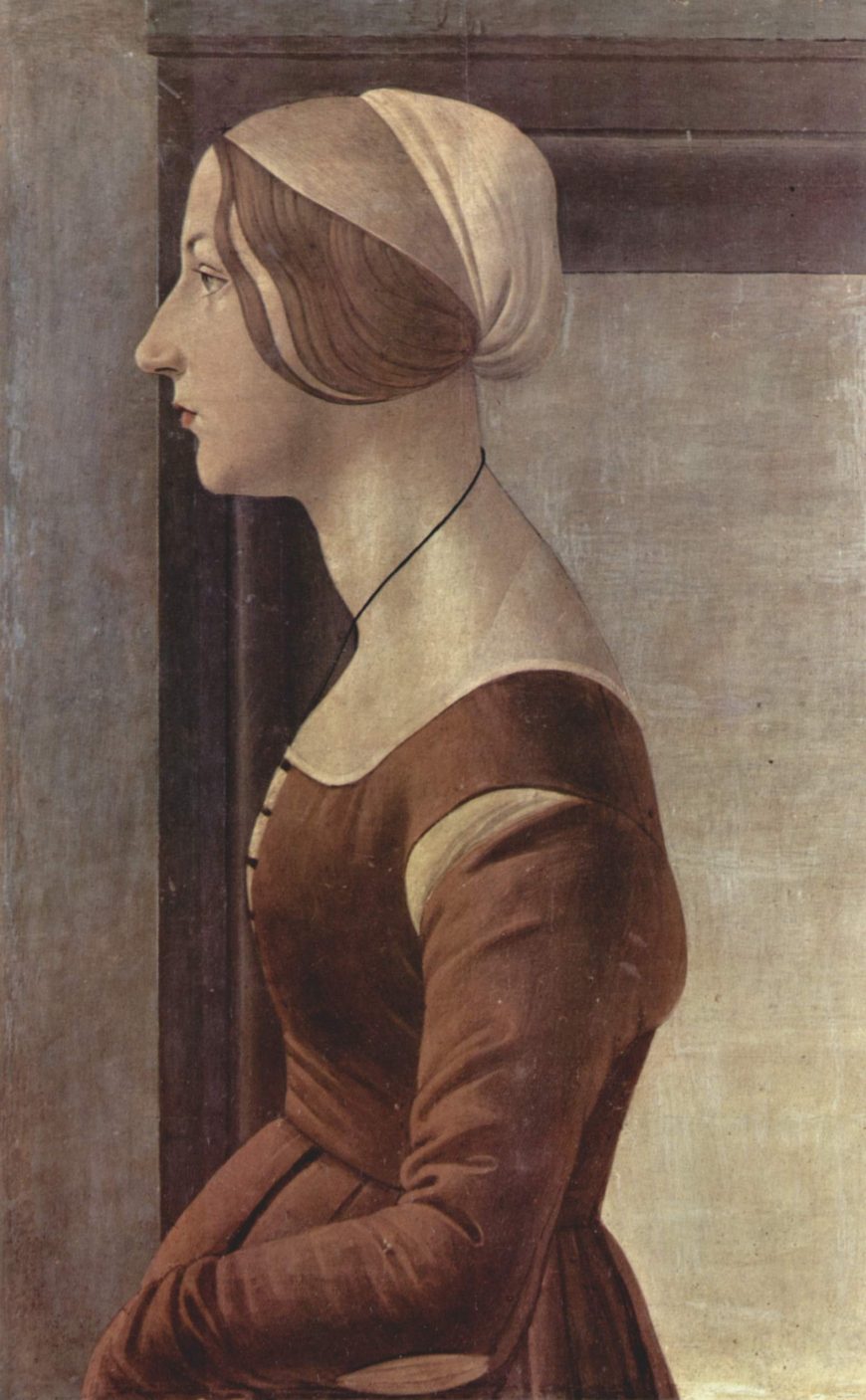
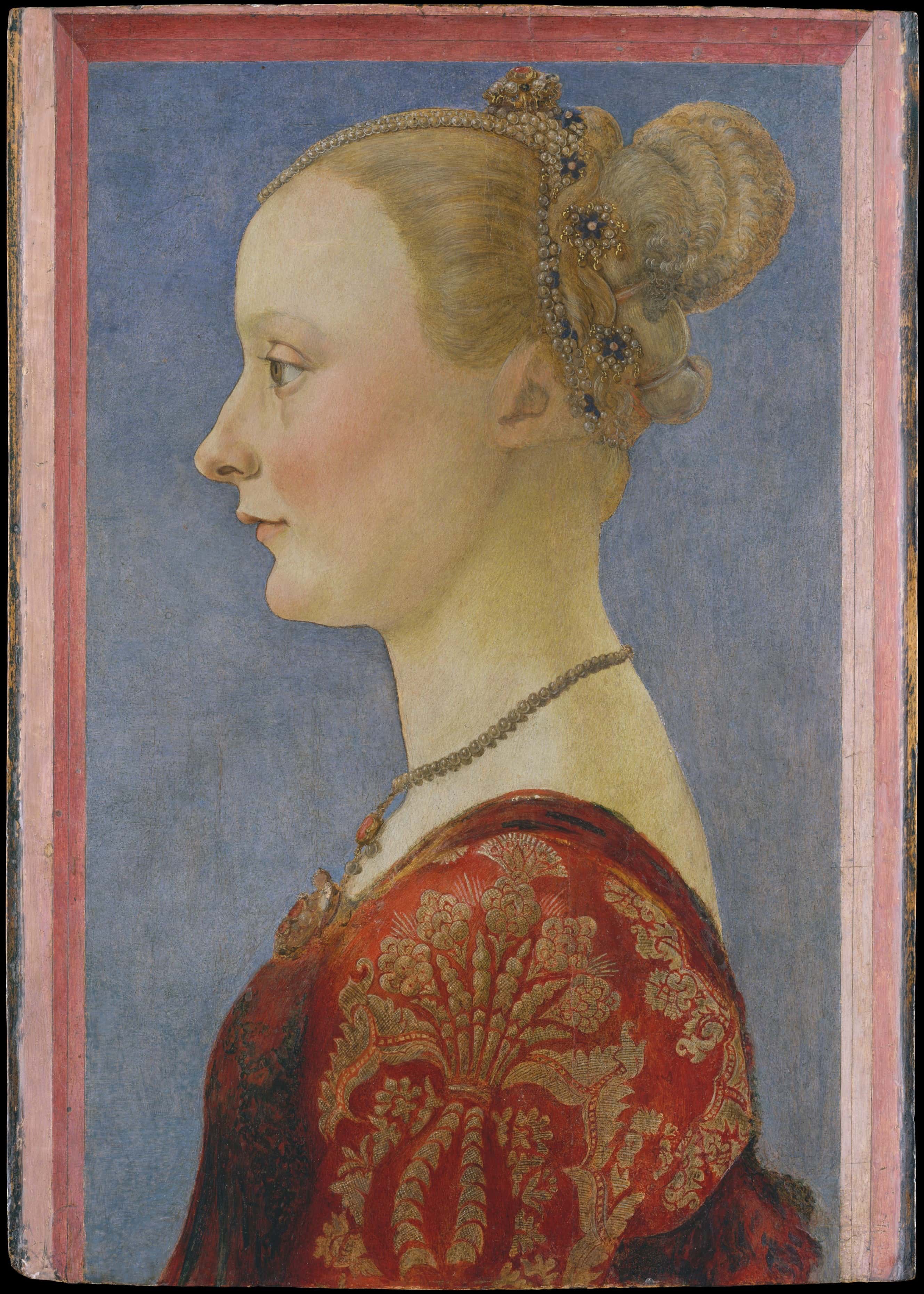
Portraits and fashion
Sandro Botticelli is best known for his masterpieces The Birth of Venus and Primavera, but during his prolific career, Botticelli also painted several portraits of contemporary Renaissance Florentines — including Portrait of a Young Woman, currently held in Florence’s Pitti Palace.
Portraits of early modern women are especially important art historical survivals, because less information is known about women’s lives in this period. Although the figure in Botticelli’s Portrait of a Young Woman lacks flashing jewels and eye-catching brocades (as featured in this portrait by Pollaiuolo), likenesses such as this one elucidate upper-class women’s daily lived experience. While Botticelli’s Portrait of a Young Woman may strike modern viewers as simple, the picture showcases early modern Florentine gender roles through its depiction of dress.
Dressing down
Depicted clothing provides key iconographic clues for art and fashion historians. During the Renaissance, clothing signaled social rank, marital status, and gender differentiation. Public dress for the upper classes was ostentatious, expensive, and designed to be attention grabbing, with intricately patterned and brightly dyed silks. However, indoor clothing was much simpler, especially for women.
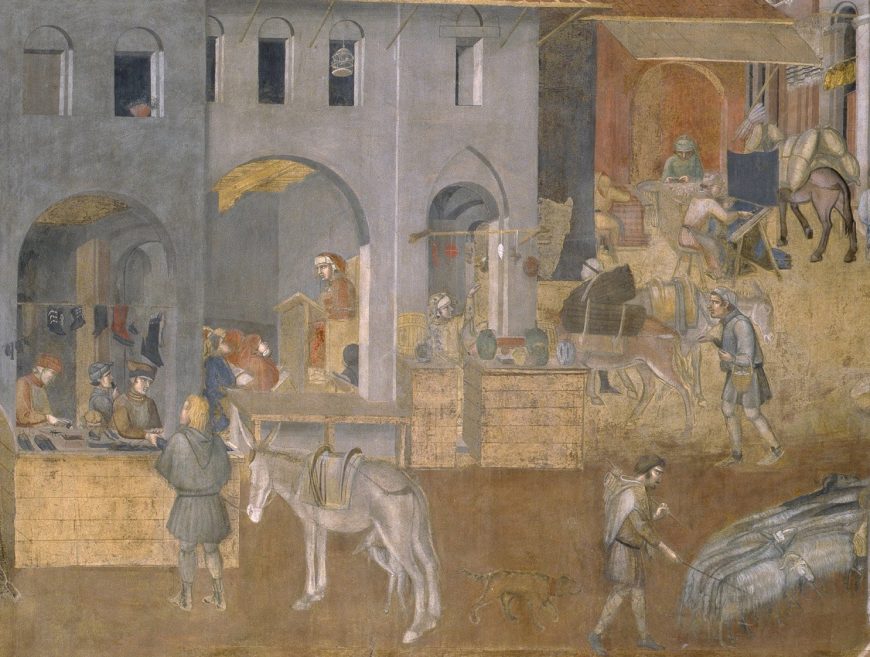
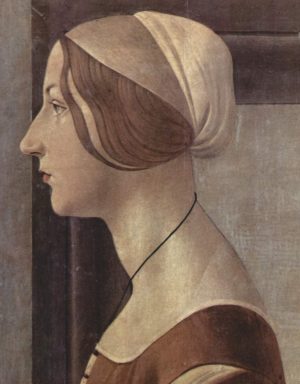
Florentine Renaissance women and men lived in very different worlds. Generally, men supervised the public-facing business domain, while women oversaw the management of the domestic sphere. While there were many exceptions to this dichotomy, upper-class wives usually oversaw the daily running of the household.
Indeed, it is safe to assume the woman in Botticelli’s painting is married, based on her dressed-down, indoor style. Her bound-up hair, for example, was a typical hairstyle for married women (unmarried women commonly wore their hair down). Further, this figure is doubtless an upper-class woman, based on the sturdiness of her gown and its fine details (and, of course, because her family was wealthy enough to commission a portrait from a famous painter).
Clothing and status
While the dress in Portrait of a Young Woman is unassuming, it is not cheap. The overgown—the outermost dress layer—is tailored from a plain brown material, possibly cotton. Using a heartier textile assured the gown would last for years of indoor wear. This dress was designed for supervising the home, including tasks like instructing servants and overseeing deliveries. It was meant to be moved in. The figure’s waist is encased in deep pleats. Her skirts push forward, and are so full with extra fabric that she has shoved her hands into their depths via pockets. Her brown locks are swept up in a simple cotton cap.
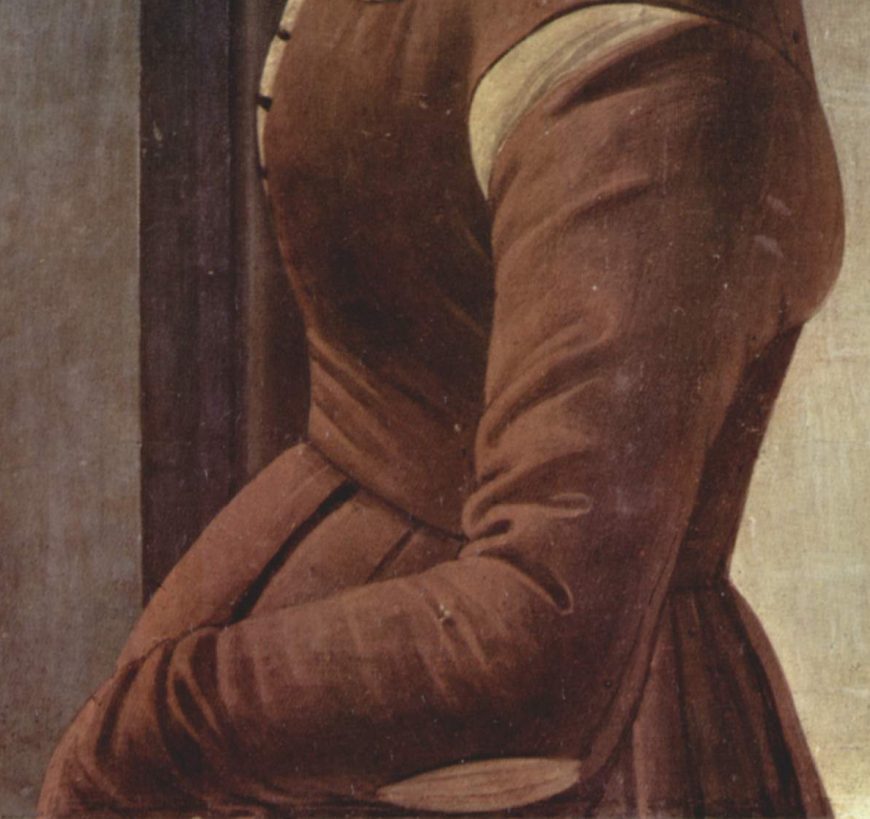
Clues confirming the figure’s high status embellish the plain outfit. A black ribbon necklace, possibly ending in an unseen cross pendant, (a popular accessory at the time), hangs from her neck. This woman wears at least one undergown, which can be seen peeking from the edges of her neckline, beneath the frontal laces. The undergarment has also been pulled out from sleeve gaps at the arm seam and elbow. A sheer lace partlet modestly covers her shoulders, and a translucent material, possibly silk or more lace, completes the bonnet to shield her hair, a symbol of wifely rejection of vanity.
The woman stands before a frame, possibly to a door or a window, a device which confirms the figure is pictured indoors — adhering to cultural norms. Although married Renaissance women were generally associated with indoor spaces, upper-class wives still led vibrant social lives. This plain brown dress, as typical private daywear, would have been appropriate garb for hosting friends and relatives at home. While much subdued as opposed to the type of costume an upper-class woman would adopt for public outings, the outfit worn by Portrait of a Young Woman provides viewers with an intimate glimpse into the Renaissance home.
“I Could Not See Her to My Satisfaction”
It is possible the woman pictured in Botticelli’s Portrait of a Young Woman is Clarice Orsini, a daughter of the noble Roman Orsini family. In June of 1469, at the age of nineteen, Clarice Orsini married the de facto prince of Florence, Lorenzo the Magnificent de’Medici. The Medici were merchant bankers and the most powerful family in Florence, so a marriage into a prominent and aristocratic Roman family served to further solidify their planned dominance of Tuscany. If the figure in Portrait of a Young Woman is indeed Clarice Orsini, Botticelli, as a Medici court painter, was tasked with creating a humble portrait of Lorenzo de’Medici’s virtuous wife assuming appropriate, indoor female gentility.
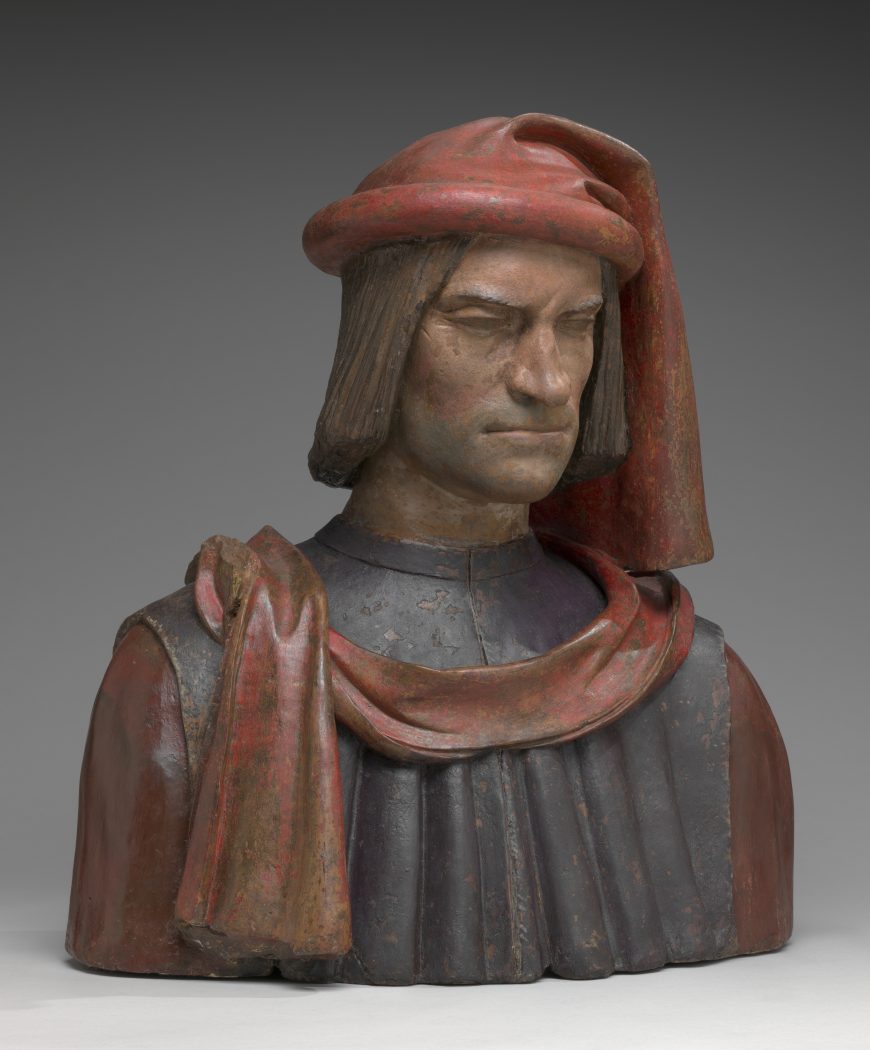
As with most political marriages, Clarice and Lorenzo’s bond was arranged by the couple’s parents. Lucrezia de’Medici, Lorenzo’s mother and the matriarch of the Medici family, wrote letters to her Florentine kin when she visited Rome to meet with Clarice’s parents and assess the girl’s aptitude towards a union with her son. In March 1467, Lucrezia reported back to her husband Piero de’Medici about the potential alliance between the Medici and Orsini. In the letter, Lucrezia segments the shy Clarice to her smallest attributes, describing her hair color, hands, and posture to Piero. Lucrezia wished to know whether the prospective adolescent bride seemed physically qualified for childbearing and furthering of Medicean lineage. Indeed, Lucrezia complains twice in the same letter that she could not get a clear look at Clarice’s body during her visit.
The Medici mother grumbles that her intense parental vision was impeded by a Roman lenzuolo (a long, breezy cloak) Clarice wore, objecting:
in this dress she seemed to me handsome, fair, tall, but being covered up I could not see her to my satisfaction.Lucrezia Tornabuoni and Cesare Guasti, Tre lettere di Lucrezia Tornabuoni a Piero de’ Medici ed altre lettere di vari concernenti al matrimonio di Lorenzo il Magnifico con Clarice Orsini ricordo di Nozze nel gennaio 1859, ([Cesare Guasti] per Felice Le Monnier, 1859), p. 9.
A few lines later, Lucrezia continues to decry her inability to speculate on the girl’s form, lamenting “her bosom I could not see, as here the women are entirely covered up, but it appeared to me of good proportions.” Lucrezia’s letters clarify how important clothing and beauty was to the political and social movements of the Renaissance world. The Medici matriarch’s concern proved needless, as Clarice gave birth to ten children, six of whom survived into adulthood. One of Clarice’s sons even grew up to be Pope Leo X.
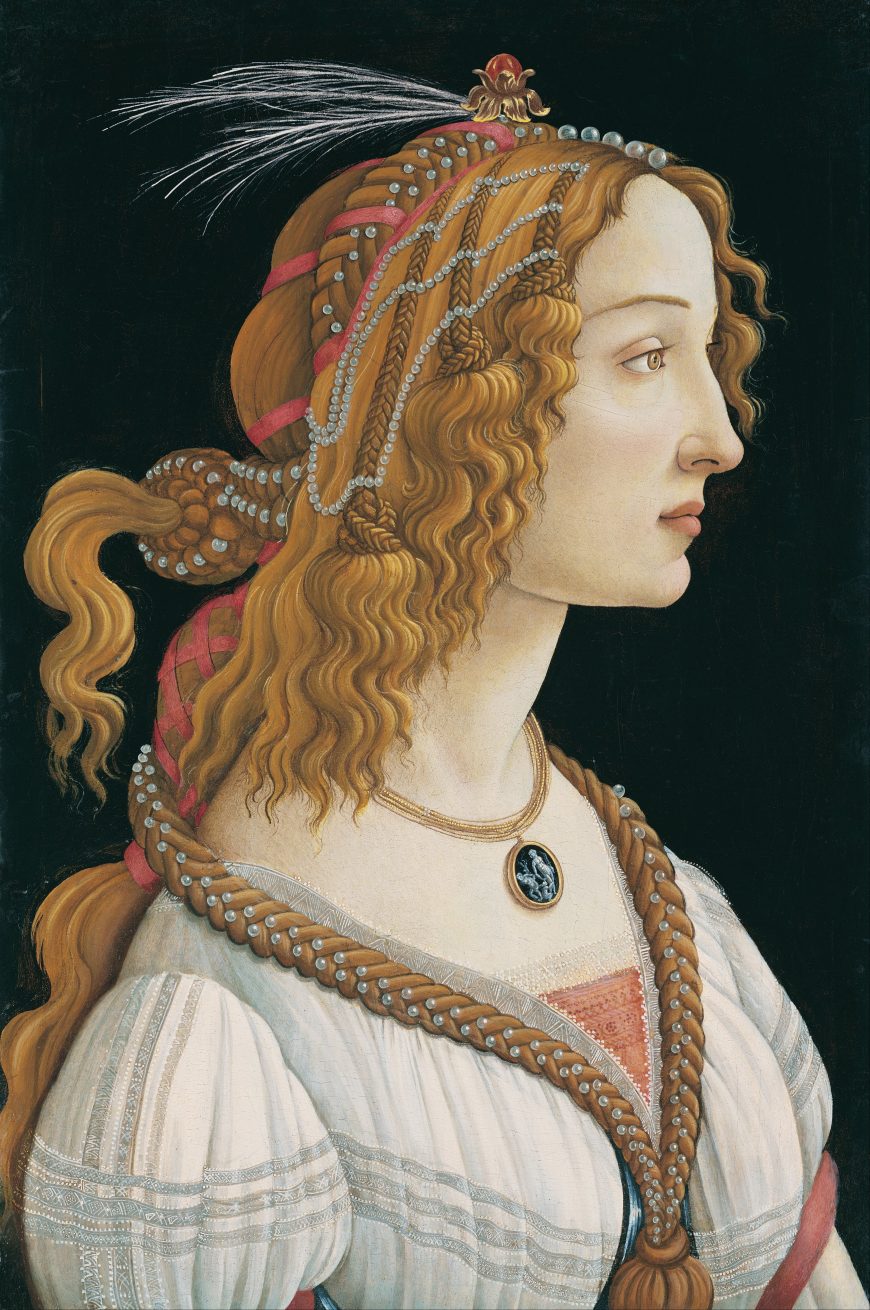
Fantastical Beauty
The intimacy displayed by the figure’s dress is rare for the period, and offers a unique glimpse into how public and private notions of Renaissance womanhood diverged. Comparing Botticelli’s Portrait of a Young Woman (possibly Clarice Orsini) with another, slightly earlier painting, also entitled Portrait of a Young Woman, clarifies the wide range of female beauty standards in Renaissance Florence.
While Botticelli depicts Clarice Orsini in indoor garb, this young lady, in stark contrast, is portrayed in fantastical dress. Fantastical dress is an imagined clothing style, depicted in images as even more ostentatious than common public wear. Some scholars have linked fantastical dress to Florentine public processions, which often included a costume element called “disguisement.”[1]
In this Portrait of a Young Woman, Botticelli has broken with strict profile to give the viewer a hint of the sitter’s left hazel eye. Lace detailing enlivens her white gown with its pink undergarment. The figure’s neck is long and slender, and her forehead is elongated with thinly-plucked eyebrows, both of which were considered attractive physical attributes at the time.
Details, Sandro Botticelli, Portrait of a Young Woman, 1480–1485
Her hair is blonde, the shade considered most beautiful for women in the period, which is why many Renaissance depictions of Mary show the Mother of God with golden-colored hair. Sprays of feathers spring from the broach in the figure’s hair, and pearls (symbols of chastity and sometimes pregnancy) dot the hairstyle. With its braids, ribbons, curls, and intricate knotting, it is unlikely this coiffure could have been achieved in reality.
A fabled beauty
Some scholars believe the woman pictured in this image is Simonetta Vespucci, another contemporary Florentine woman associated with the Medici family. Simonetta Vespucci was the “it-girl” of Quattrocento Florence, considered one of the most beautiful women in the city. Both Medici male heirs, Lorenzo de’Medici the Magnificent and his younger brother Giuliano de’Medici, publicly declared their admiration for Simonetta.
Signs identifying Simonetta’s connection with the Medici are found in the figure’s jewelry; the cameo hanging from her neck depicts a scene of the Greek god Apollo flaying Marsyas for displeasing him. The Medici, possibly Lorenzo himself, owned a very similar cameo.
In 1476, Simonetta Vespucci died tragically young at the age of twenty-two, likely of tuberculosis. The entire city of Florence mourned her loss. Botticelli, therefore, may have created this likeness posthumously. After her death, Botticelli created many similar portraits of fantastically beautiful young women, which also may or may not portray Simonetta Vespucci.
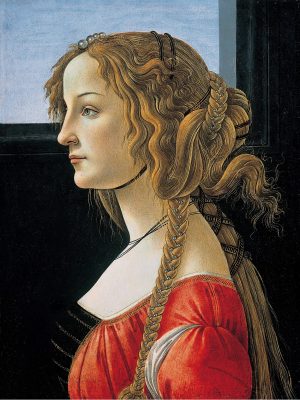
Indeed, some scholars even believe Venus and Flora in the Birth of Venus and Primavera, respectively, were also inspired by the real-life Florentine beauty queen. When creating his compositions such as the iconic Birth of Venus, Botticelli often collaborated with the Medici court poet, Poliziano, who wrote many versus praising Simonetta Vespucci’s beauty.
Types of beauty
Both of the Botticelli portraits discussed in this essay — of young, Florentine women — showcase wildly different visual conceptions of Renaissance female beauty. Together, the images tell a story about legacy, patriarchy, and two women deeply connected to and beloved by one of the most powerful and influential dynasties in early modern Europe.
Notes:
- Charles Dempsey, “The End of the Masquerade,” Inventing the Renaissance Putto (Chapel Hill: UNC Press, 2001), 203-208.
Additional resources:
Charles Dempsey, “The End of the Masquerade,” Inventing the Renaissance Putto (Chapel Hill: UNC Press, 2001).
Claudia Wedepohl, “Why Botticelli?: Aby Warburg’s Search for a New Approach to Quattrocento Italian Art.” In Botticelli Past and Present, edited by Ana Debenedetti and Caroline Elam (UCL Press, 2019), pp. 83–202.
Idealised Portrait of a Lady (Portrait of Simonetta Vespucci as Nymph)
Janet Ross, Lives of the Early Medici: As Told in Their Correspondence, (R.G. Badger, 1911).
Lucrezia Tornabuoni and Cesare Guasti, Tre lettere di Lucrezia Tornabuoni a Piero de’ Medici ed altre lettere di vari concernenti al matrimonio di Lorenzo il Magnifico con Clarice Orsini ricordo di Nozze nel gennaio 1859, ([Cesare Guasti] per Felice Le Monnier, 1859).
Patricia Simons, “Women in Frames, the Gaze, the Eye, the Profile in Renaissance Portraiture.” History Workshop Journal 25, no. 1 (1988), pp. 4–30.
Dissecting Botticelli’s Adoration of the Magi
by TED-ED
Video \(\PageIndex{18}\): Video from TED-Ed. Speaker: James Earle.
Perugino, Decemviri Altarpiece
by DR. STEVEN ZUCKER and DR. BETH HARRIS
Napoleon’s confiscation of thousands of works of art forever changed the cultural landscape of Europe.
Video \(\PageIndex{19}\): A conversation with Dr. Steven Zucker and Dr. Beth Harris in front of Perugino, Madonna and Child with Sts Laurence, Louis of Toulouse, Ercolanus and Constance (Decemviri Altarpiece), 1495–96, tempera on wood, 193 x 165 cm (Vatican Museums)
Piero della Francesca
Piero della Francesca, The Baptism of Christ
by DR. BETH HARRIS and DR. STEVEN ZUCKER
Video \(\PageIndex{19}\): Piero della Francesca, The Baptism of Christ, 1450s, tempera on wood, 167 x 116 cm (National Gallery, London)
Additional resources
Smarthistory images for teaching and learning:
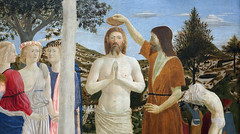
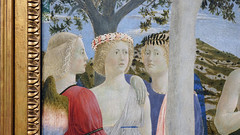
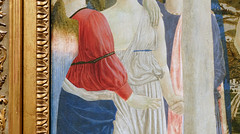
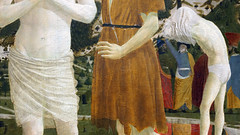
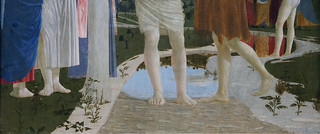
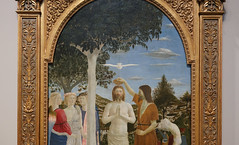
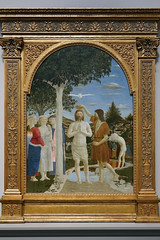
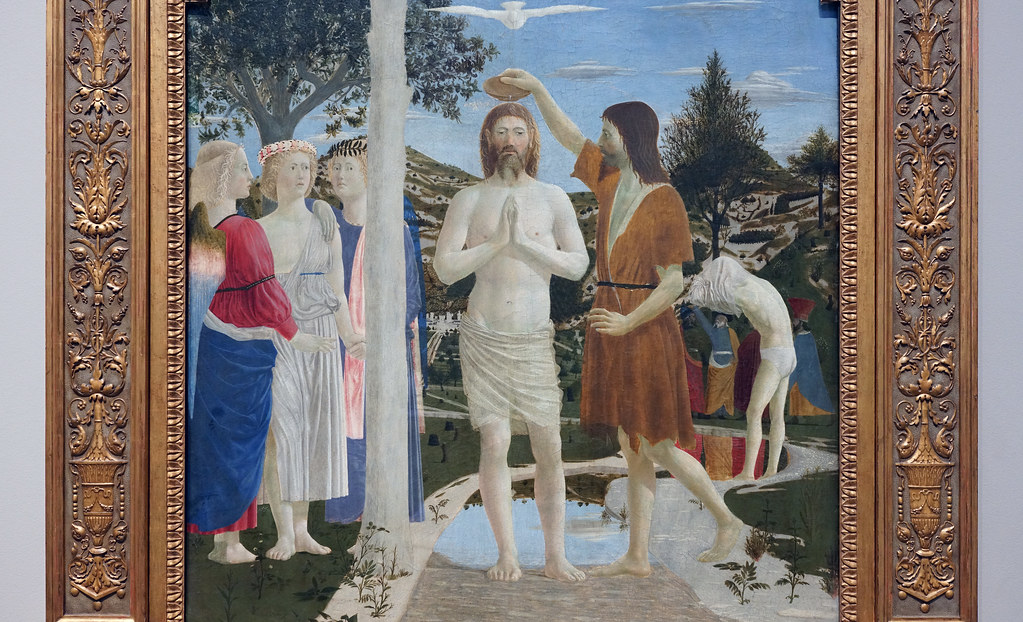
Piero della Francesca, Flagellation of Christ
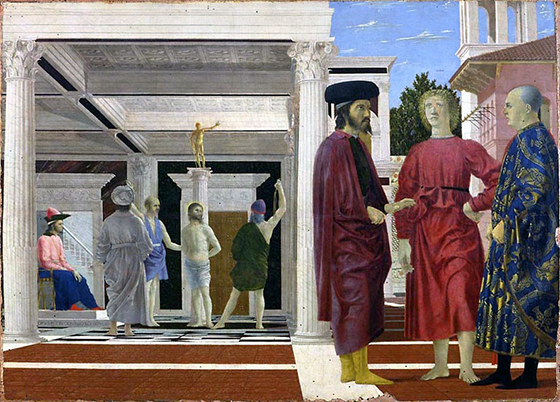
The subject of the Flagellation
Piero della Francesca’s Flagellation of Christ is proof that, sometimes, good things really do come in small packages. Despite the panel’s size (only 58.4 cm × 81.5 cm), the painting has been a mainstay in the last century in discussions of Quattrocento (fifteenth century) painting. An early example of the use of oil paint—though Piero used both tempera and oil in its execution—the work depicts the moment in Christ’s Passion when he was whipped before Pontius Pilate. Though the New Testament says very little about this moment, mentioning only that Pilate ordered Christ to be flogged, later Christian writers wrote much about the event and even speculated about the number of lashes Christ received. Though the New Testament does not say that Christ was tied to a column while being whipped, during the fifteenth century this became a convention in depictions of the scene, which Piero here follows.
A masterpiece of the early Renaissance
This painting is a masterpiece of the Early Renaissance. The figures are expressive; especially noteworthy is the face of the bearded man in the foreground. They are also given real volume through the use of modeling (the passage from light to dark over the surface of an object). True to Humanism, the painting shows a preoccupation with the classical world, as seen especially in the architecture and inclusion of the golden statue in the background. Above all, Piero’s obsession with perspective (the naturalistic recession in to space), is evident. In fact, the artist was the author of a treatise on perspective, entitled De Prospectiva Pingendi (On the Perspective of Painting) and was also known as a mathematician and geometer.

Who are the men in the foreground?
But Piero della Francesca’s picture is also highly unusual. The flagellation, which is the gruesome main event, takes place in the background, while three extraneous men are painted prominently in the foreground. Piero uses two main devices to further emphasize the division of subjects. The first is setting. While the flagellation takes place inside of a covered courtyard with dramatic black and white checked tiles, the men are outdoors standing on the reddish tiles that pervade the scene. The second is the use of the orthogonal lines of the perspective, which divide the painting in half, and also delineate the interior and exterior space.
Not only is the painting strange because Piero marginalized the primary subject, relegating it to the back of the painting, but also because art historians cannot agree on who the three men in the foreground are. Theories abound.
The traditional identification of these three men is that the young man in the center is Oddantanio da Montefeltro, ruler of Urbino, flanked on either side by his advisors. All three of these men were killed in a conspiracy. In this case, it is suggested that the patron of the painting was Federigo da Montefeltro (who was later immortalized in a famous diptych by Piero) to commemorate his brother’s death and compare his innocence to that of Christ.
Art historian Marilyn Lavin offered another notable interpretation of the painting. She suggested that the two older men are Ludovico Gonzaga and a friend, who had both recently lost their sons, symbolized by the young man in the center. The painting in this case would compare the pain that the two fathers felt to that of Christ during his Passion.
Other art historians have suggested that the painting is an allegory for the suffering of Constantinople after its fall to the Muslims in 1453. In this view, the two men watching the flagellation are Murad II (the Islamic sultan who waged a decades-long war against Christianity), and Byzantine Emperor John VIII Palaiologos (against whom that war was waged). The emperor had gone to the 1438 Council of Florence to ask for protection from the Muslims, but received no aid. The three enigmatic men, then, represent nobles who stood by and let the Christian nation be destroyed.

Still another interpretation suggests that the key to understanding the painting lay in the lost inscription on the frame, which putatively said, “Convenerunt in unum,” or “They come into one.” This is a line from the Bible that was traditionally read each year on Good Friday, the day that commemorates Christ’s Passion. “They” would refer then to the Sanhedrinists, or councilmen of Israel, who were present during Christ’s suffering. In this way of looking at the panel, Piero did not include a contemporary political message, but rather painted a narrative that is true to the text, and depicts exactly what it purports to, the flagellation of Christ.
No definitive interpretation
The enigmatic nature of Piero della Francesca’s Flagellation underscores the fact that works of art, regardless of their age, continue to engender interesting art historical research. In the case of this painting, it is unlikely that a definitive interpretation will ever be accepted, as there is little documentation to support a single argument. Perhaps this ambiguity is partially why the painting continues to intrigue, and, almost 600 years later, grants multiple entry points to the viewer, drawing him into Piero’s fictional world.
Additional resources:
R. Wittkower and B. A. R. Carter, “The Perspective of Piero della Francesca’s Flagellation, Journal of the Warburg and Courtauld Institutes, vol. 16, no. 3/4 (1953), pp. 292-302.
Marilyn Aronberg Lavin, Piero della Francesca’s Flagellation: The Triumph of Christian Glory, The Art Bulletin, vol. 50, no. 4 (Dec., 1968), pp. 321-342.
Ludovico Borgo, “Piero della Francesca’s Flagellation: The Figures in the Foreground” The Burlington Magazine,vol. 121, no. 918 (Sep., 1979), pp. 546-553+557.
Ludovico Borgo, New Questions for Piero’s Flagellation, The Burlington Magazine, vol. 121, no. 918 (Sep., 1979), pp. 546-553+557.
Joseph Hoffman, Piero della Francesca’s “Flagellation”. A Reading from Jewish History, Zeitschrift für Kunstgeschichte 44. Bd., H. 4 (1981), pp. 340-357.
Piero della Francesca, Resurrection
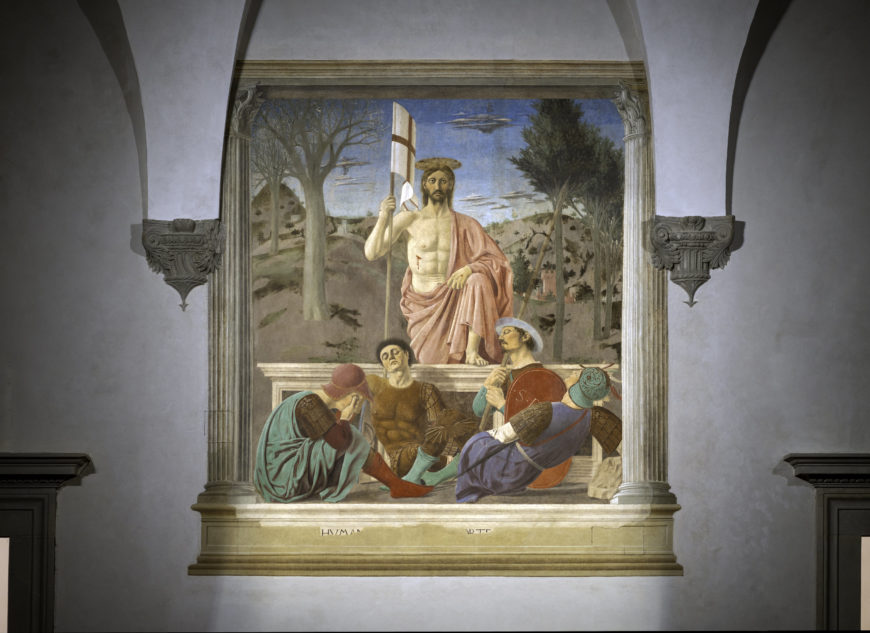
Saved from destruction
Although Da Vinci’s Last Supper is perhaps the most famous fresco that was nearly destroyed during World War II, the people of the Italian town Sansepolcro in Tuscany contend that they, in fact, hold the most important work spared in the war. For this, they can thank commanding British artillery officer and great appreciator of art, Tony Clarke, who was supposed to raze the city, but defied orders—having read Aldous Huxley’s comment that Sansepolcro was home to the best painting in the world. Huxley, of course, was referring to Piero della Francesca’s famed fresco, The Resurrection.
A relic of the holy sepulcher
Piero painted this fresco around 1463 in the civic hall of Sansepolcro, which had been occupied by the Florentines but was recently returned (the Italian city-states were often at war). The subject matter then—the triumphant Christ arising from his tomb the third day after his death—may be a reference to the triumph of the town itself, which was named after the Holy Sepulcher (Sansepolcro in Italian, and the Holy Sepulcher is the tomb that Christ was buried in). The presence of the large stone in the lower right hand corner of the fresco supports this, as it possibly represents the relic of the sepulcher (the burial place, in this case of Christ) putatively brought to Sansepolcro by the saints who founded the town, Arcano and Egidio.
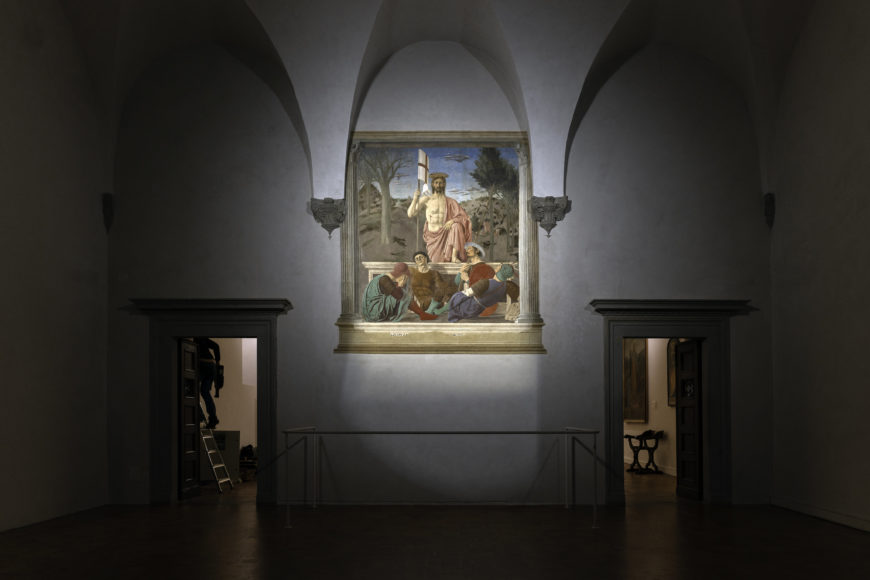
An interest in more than naturalism
Unlike other paintings by Piero (The Flagellation for example), The Resurrection is less interesting iconologically than it is formally; that is, art historians are less concerned about what it might mean than what it actually looks like. Although The Resurrection is often depicted by having Christ emerge from a cave from which a boulder has been “rolled away,” Piero instead chose to show Jesus stepping out of a Roman sarcophagus. In the foreground of the painting, the Roman soldiers ordered to guard the tomb have all fallen asleep. The position of their bodies is quite interesting. The reclining soldier certainly could never actually maintain that pose while sleeping in real life, and his comrade next to him, holding the lance, doesn’t even have legs. These two details show that Piero was more concerned about achieving a pleasing composition than being true to life.
Also noteworthy is that, although we know that Piero was the author of a major treatise on perspective and was also a mathematician and geometer, the painting contains two vanishing points (the point at which all the lines of the painting should converge). On one hand, we see the faces of the soldiers from below, but on the other hand, the face of Christ is painted straight on. If the perspective were consistent throughout the painting, we would see all the faces from the same vantage point. Again, Piero has sacrificed realism for effect.
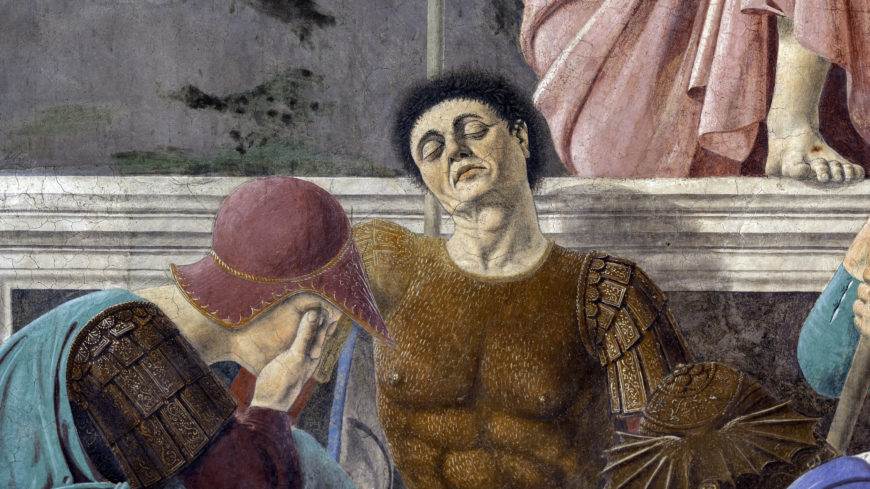
A self-portrait?
Perhaps the most striking feature of Piero’s fresco is the physical reality of the people he paints. Piero has been lauded as one of the first painters of the Renaissance to capture realistic faces that show emotion. In fact, Giorgio Vasari, the great sixteenth-century art historian and painter, reported that the face of the soldier in brown armor was a self-portrait of Piero. Although there is no way of knowing if this is true—and Vasari is known for not always being accurate—his inclusion of this detail underscores the fact that Piero’s human figures are not just made-up “types,” but contain a spark of individuality that makes them feel like they are based on observations from real life. This is one of the major differences between Renaissance and Medieval art, and is partly why Piero is considered one of the great early Renaissance painters.
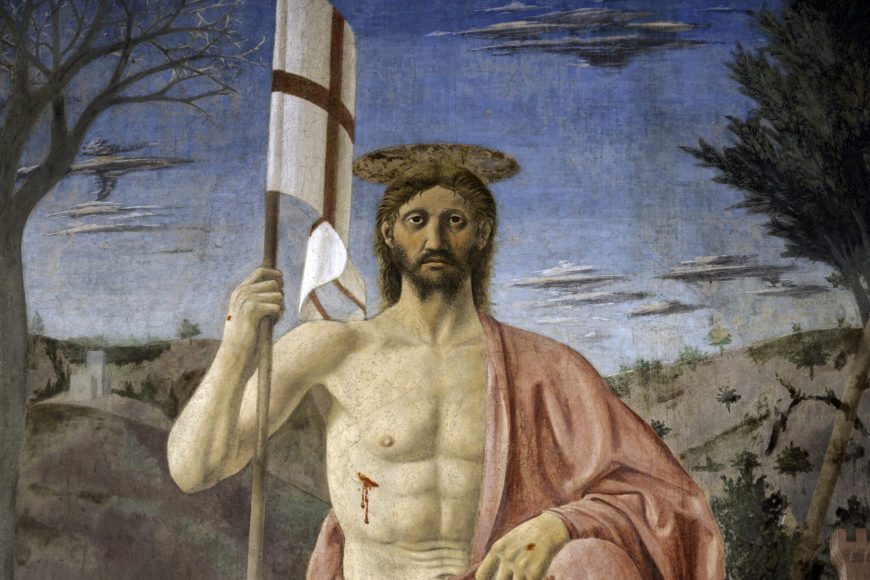
Geometry and mass
Piero has organized the figures so that an isosceles triangle is formed from the top of Christ’s head, through the soldiers, to the lower corners of the paintings. In addition, a tree is placed almost-symmetrically on either side of Jesus. This emphasis on geometric order and harmony is typical of the Renaissance, as best exemplified by paintings such as Raphael’s School of Athens, and Leonardo’s Last Supper.
Also characteristic of Piero’s work is the mass of the bodies, an effect achieved in a variety of ways. Perhaps the most obvious is the stalwart pose of Christ, who appears anchored to the tomb by both his left leg and the flag in his right hand. At the same time, he seems to actively be using the flagpole and the hand on his knee to raise his other leg out of the tomb. The flexed muscles of his abdomen also emphasize the reality of Christ’s body, which is physically engaged despite the serenity of his face.
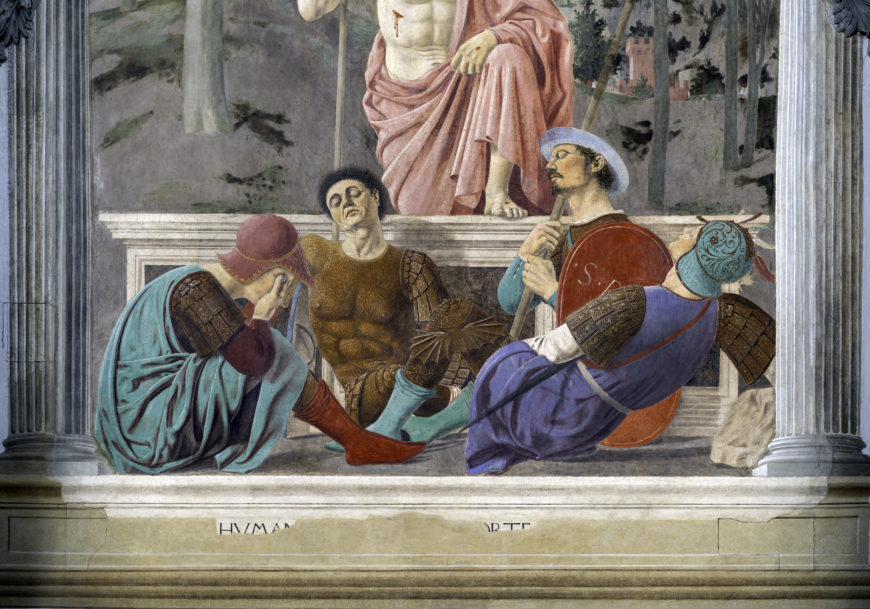

The complex positioning of the soldiers’ bodies also adds to this feeling of mass. Piero overlaps the men, intertwining their feet, so that they appear to exist in real space. The abdomen of the soldier in brown also echoes that of Christ, lending him an even greater sense of realism. The soldier all the way to the left, whose body is curled almost into a ball and whose face is hidden, is reminiscent of a similar figure in Giotto’s Lamentation, who is also used at the corner of the painting to anchor the eye and add weight to the composition.
Thanks, Tony
Not many of Piero’s paintings have survived, and those that have are scattered around the globe; few are in major museums. However, it is certainly worth the train ride from Florence to see this gem of the early Renaissance. And when you do, be sure to remember to thank Tony Clarke, without whom this painting would have become a pile of dust.
Additional resources:
The Man who Saved the Resurrection from BBC News
James Elkins, “Piero della Francesca and the Renaissance Proof of Perspective,” The Art Bulletin, Vol. 69, No. 2 (June, 1987) , pages. p. 220-230.
Piero della Francesca, The Resurrection
by DR. STEVEN ZUCKER and DR. BETH HARRIS
Video \(\PageIndex{20}\): Piero della Francesca, The Resurrection, c. 1470 (fresco, 225 x 200 cm (Museo Civico, Sansepolcro, Italy)
Smarthistory images for teaching and learning:
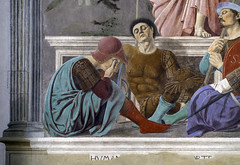
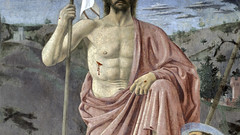
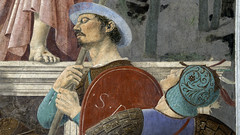
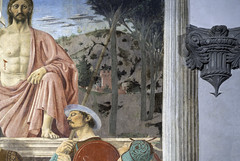
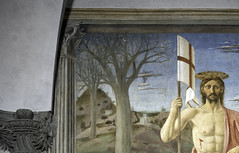

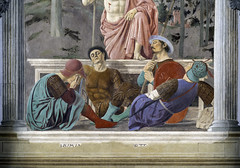

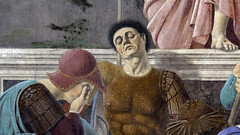
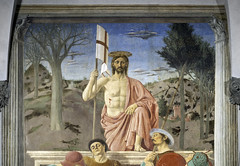

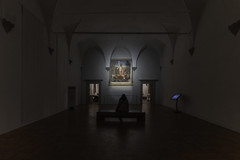
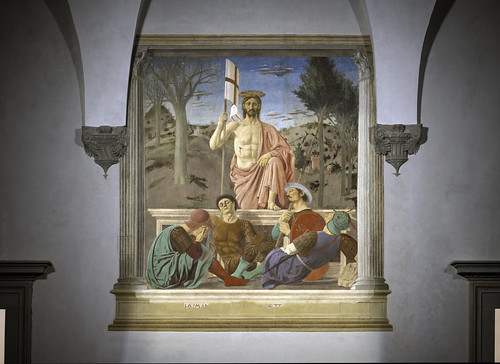
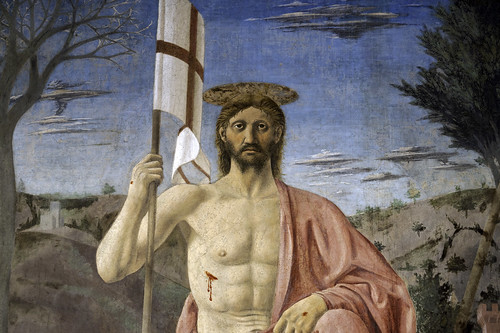
Piero della Francesca, Portraits of the Duke and Duchess of Urbino
by DR. STEVEN ZUCKER and DR. BETH HARRIS
Video \(\PageIndex{21}\): Piero della Francesca, Portraits of the Duke and Duchess of Urbino (Federico da Montefeltro and Battista Sforza), 1467-72, tempera on panel, 47 x 33 cm (Galleria degli Uffizi, Florence)
Luca Signorelli, The Damned Cast into Hell

Imagine being confronted by this scene—men and women screaming, their nude bodies contorted in pain as they are tortured by garishly colored demons.

Off to the side, a fiery pit awaits these unfortunate souls. Fragmented bodies of those already consigned to the flames are visible through the acrid smoke.

Above, demons and humans tumble through the sky. Standing next to them on small clouds are the three archangels, Michael, Gabriel, and Raphael, fully clad in suits of armors, drawing the swords at their sides. Although you might be wondering, what on earth is going on here—to a fifteenth century viewer it would have been quite obvious.

Painted by Luca Signorelli from 1499 to 1503 in the San Brizio Chapel in the Cathedral in Orvieto, Italy, the fresco represents one part of the End of Days narrative, when Christ returns to judge mankind—and to separate those who will go to heaven (the blessed) from those who will go to hell (the damned). An account of this event is found in the Gospel of Matthew (25:31-46), which reads in part:
But when the Son of Man comes in his glory, and all the holy angels with him, then he will sit on the throne of his glory. Before him all the nations will be gathered, and he will separate them one from another, as a shepherd separates the sheep from the goats. He will set the sheep on his right hand, but the goats on the left; Then the King will tell those on his right hand, ‘Come, blessed of my Father, inherit the Kingdom prepared for you from the foundation of the world… Then he will say also to those on the left hand, ‘Depart from me, you cursed, into the eternal fire which is prepared for the devil and his angels;…These will go away into eternal punishment, but the righteous into eternal life.
In this passage the sheep are the faithful who have followed Christ in a sin-free life and the goats were those who did not. This subject was a popular visual means of illustrating the rewards and punishments that awaited the lay person at the end of time. It was most often depicted in a single composition, such as in Giotto’s Last Judgment fresco in the Arena Chapel.

Here we see Christ enthroned in the top center, flanked by the Apostles on either side. In the lower portion of the composition are representations of the two sides—the “sheep” and the “goats.” On Christ’s right hand side (the left side of the viewer) are the Elect, those who have been chosen to go to Heaven, some of whom are still emerging from their tombs, while on his left hand side, we see the Damned, those who have been consigned to the fiery pits of Hell and are being tortured by demons. Giotto’s Last Judgment was placed over the door into the chapel, thus providing visitors who were leaving a clear visual message.

In the case of the San Brizio Chapel, the entire chapel was used to represent this subject, not just one wall, and this was a rather unique situation. The subject was divided into six large, individual scenes including The Elect being called to Heaven, the Resurrection, the Deeds of the Antichrist and the Apocalypse. The Damned is located next to the altar wall—where we see another fresco, those consigned to Hell being carried across the river to the underworld (above).

One of the most striking aspects of Signorelli’s fresco is his representation of the nude figure. In fact, the Damned, along with its companion scene of the Elect (directly across the chapel on the opposite wall) seem to have been a means for Signorelli to explore the multitude of attitudes and positions possible in the human body. In the Damned, the brightly colored demons are pushing, pulling, tying up, and exacting all manner of physical torture on the sinners whose bodies are equally contorted, struggling to break free. The figures are all quite muscular, even hyper-muscular in some cases.
The interest artists had during this period in the study of the human figure was certainly driven, at least in part, by their interest in the classical past. As the Renaissance is the period of the “rebirth” of classical antiquity, artists looked to those exemplars of the past as ideals. For example the contropposto stance of the famous Doryphorus statue from Greece influenced most painters and sculptors of the period. There was also a general desire to understand the workings of the human body, and we can definitely perceive such interest in other similar works.

For example, Antonio Pollaiuolo’s large engraving, The Battle of the Nudes, is one of the most important works of the period. In it, Pollaiuolo shows ten nude, male figures battling each other in a fantastical landscape. Notice the two men in the foreground are in the same pose, but reversed. This way Pollaiuolo could show both the front and back side of the same position. The other figures in the background assume equally exaggerated poses and dynamic movements, illustrating the flexing of muscles as the body engages in battle. This if very much in line with what Signorelli achieved in his fresco.

Perhaps the artist most associated with the study of the male nude figure is Michelangelo and it has been suggested by scholars that he may have been influenced by Signorelli’s figures in some of his works. And indeed shortly after the completion of the San Brizio chapel, Michelangelo produced one of the most influential works of the period, The Battle of Cascina, 1504-06. In this large scale cartoon (a preparatory design for a fresco), which only survives in copies, we see many of the same interests as in Signorelli’s Damned. Michelangelo presented figures from a variety of different angles and complex positions as the soldiers rise to put on their armor and fight the oncoming enemy. And in both Signorelli’s and Michelangelo’s works, the artists were also interested in rendering various states of emotion. In both we see several figures with mouths open in exclamation along with general expressions of anxiety and fear.

In the end, when looking at Signorelli’s fresco, it is hard not to be amazed by the sheer volume and mass he was able to achieve in representing the figures three-dimensionally. The acidic coloration of the demons adds to the sense of complete chaos and upheaval. And in the midst of all of this action, we may even see the artist himself. If you look closely at the center of the composition, there is blue demon with a white horn who grabs a woman around her waist, and we see her struggle against her captor. That this is the artist’s self-portrait has generally been accepted. What remains unknown is the identity of the woman he grabs although she appears twice more in the fresco…can you find her?
Sculpture and architecture
Filippo Brunelleschi and Lorenzo Ghiberti, Sacrifice of Isaac
by DR. STEVEN ZUCKER and DR. BETH HARRIS
Video \(\PageIndex{22}\): Filippo Brunelleschi and Lorenzo Ghiberti, Sacrifice of Isaac, competition panels for the second set of bronze doors for the Florence Baptistery, 1401-2
Lorenzo Ghiberti, Gates of Paradise, East Doors of the Florence Baptistery
by DR. STEVEN ZUCKER and DR. BETH HARRIS
Video \(\PageIndex{23}\): Lorenzo Ghiberti, Gates of Paradise, East Doors of the Florence Baptistery, bronze, 1425-52
Smarthistory images for teaching and learning:


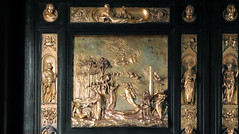
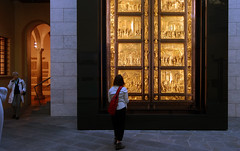


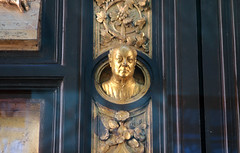
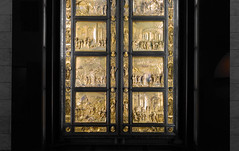
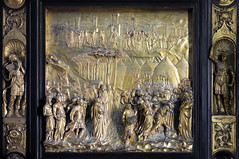
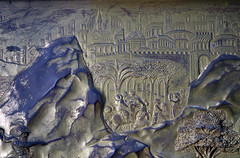
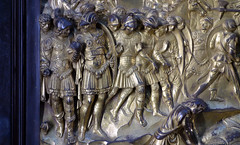
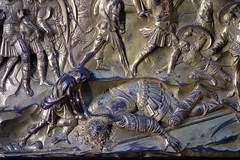
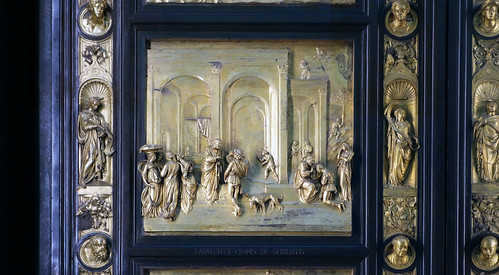
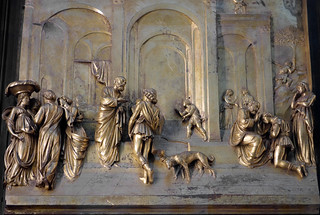
Filippo Brunelleschi
Brunelleschi, Old Sacristy, San Lorenzo, Florence
by DR. BETH HARRIS and DR. STEVEN ZUCKER
Video \(\PageIndex{24}\): Brunelleschi, Old Sacristy, San Lorenzo, Florence, begun c. 1421
Filippo Brunelleschi, Dome of the Cathedral of Florence
by DR. BETH HARRIS and DR. STEVEN ZUCKER
Video \(\PageIndex{25}\): Filippo Brunelleschi, Dome of the Cathedral of Florence, 1420-36
Smarthistory images for teaching and learning:

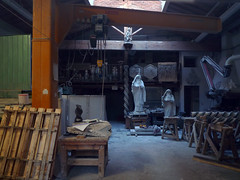
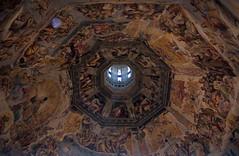
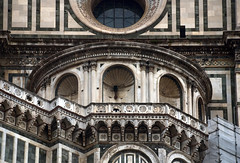
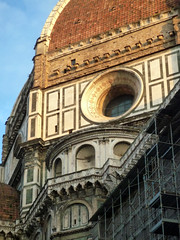
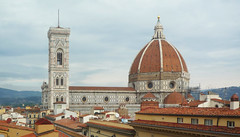
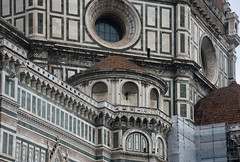
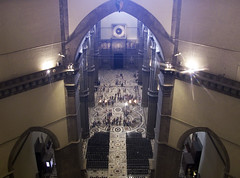


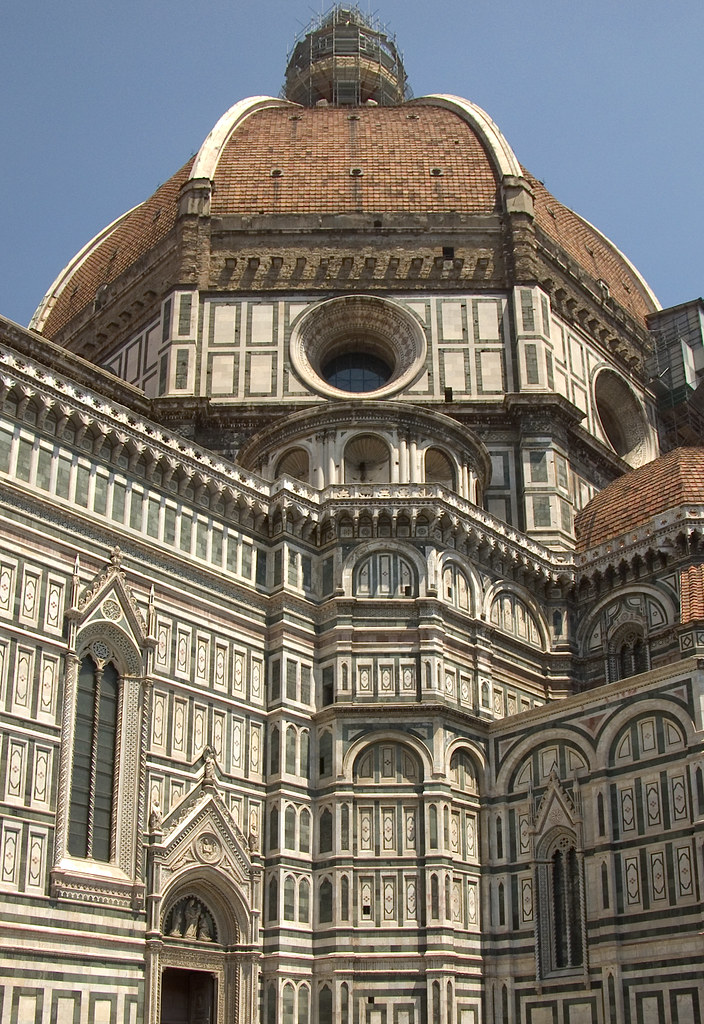
Filippo Brunelleschi, Pazzi Chapel, Florence
by DR. BETH HARRIS and DR. STEVEN ZUCKER
Video \(\PageIndex{26}\): Filippo Brunelleschi, Pazzi Chapel, Santa Croce, Florence, begun 1420s, completed 1460s
Smarthistory images for teaching and learning:

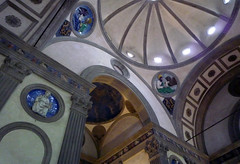
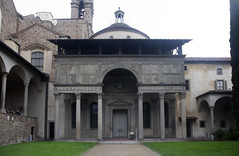
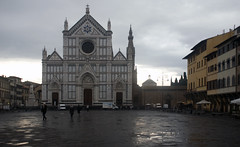










Filippo Brunelleschi, Santo Spirito, Florence
by DR. BETH HARRIS and DR. STEVEN ZUCKER
Video \(\PageIndex{27}\): Filippo Brunelleschi, Santo Spirito, Florence, 1428-81
Smarthistory images for teaching and learning:

Orsanmichele and Donatello’s Saint Mark, Florence
by DR. STEVEN ZUCKER and DR. BETH HARRIS
Smarthistory images for teaching and learning:
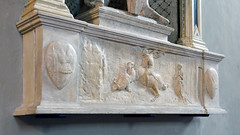
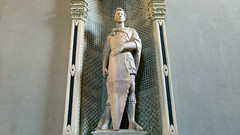
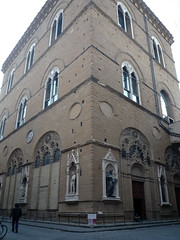
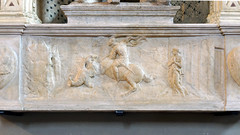
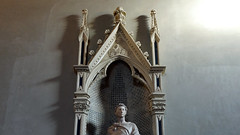
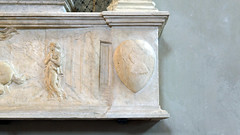
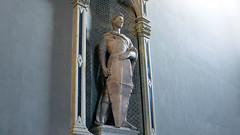



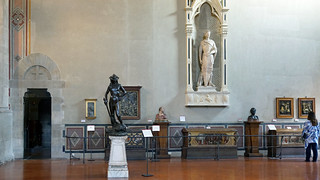

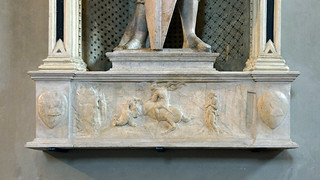
Nanni di Banco, Four Crowned Saints
by DR. STEVEN ZUCKER and DR. BETH HARRIS
Video \(\PageIndex{29}\): Nanni di Banco, Four Crowned Saints, c. 1410-16, marble, figures 6′ high, Orsanmichele, Florence (Italy)



